Matador Network's Blog, page 41
May 22, 2025
The 7 Best Soccer Bars in Seattle for Watching the World Cup
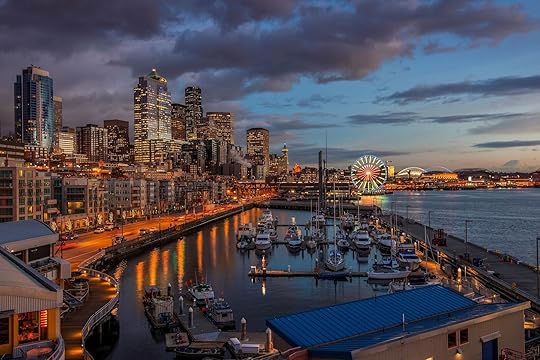
Seattle has long been a soccer-loving city. From 1974 to 1983, the Seattle Sounders played in the North American Soccer League (NASL), the US and Canada’s first professional men’s soccer league. It helped Seattle grow one of the largest fan bases for professional men’s soccer in the entire country.
Today, the Sounders consistently manage to draw some of the highest average attendance numbers in Major League Soccer, despite being a city of fewer than one million residents. In 2024, it averaged more than 30,000 supporters at home games. One of the best sights on game day is the Match March, where thousands of supporters meet at Occidental Park in Pioneer Square and walk towards the stadium together.
But it’s not just the Sounders the city loves. Seattleites will also fill stadiums and bars around Seattle in support of the women’s professional team (Reign FC, part of the National Women’s Soccer League), as well as two semi-professional teams: the men’s Ballard FC, and Salmon Bay FC women’s team.
Needless to say, Seattle is ready to host World Cup games in 2026 with bars that already serve the city’s many soccer fans. The city will have a dress rehearsal this summer as it hosts Atletico Madrid and Paris Saint-Germain for the , starting June 15, 2025.
Whether you’re looking for a Reign FC supporters bar, a place that bleeds Sounder Blue, or you want a more international futbol-loving crowd, there’s likely an ideal bar waiting for you in Seattle, complete with big-screen TVs and cold craft beers.
View this post on InstagramA post shared by UW Track & Field (@uwtrack)
Rough and Tumble is Seattle’s only sports bar that prioritizes showing women’s professional sports and is the home bar for FC Reign fans who want to watch the game with a beer in hand. It hosts events to raise money and awareness for women’s sports, and is particularly invested in women’s soccer in Seattle. Rough and Tumble owner Jen Barnes is also a part owner of Salmon Bay FC, the first United Soccer League for women in the city – the last stepping stone before going pro.
While women’s sports are the priority, Rough and Tumble shows all Sounders games, and will be one of the best spots in Ballard to come for Seattle’s World Cup watch parties. The menu is also soccer-forward, with the aptly named Reignstorm Burger and the slightly spicier vegetarian Title IX Bahn Mi. There’s also a boozy brunch menu perfect for early World Cup games — the Pickle Mary will cure whatever you got up to the night before.
Rough and Tumble Pub: 5309 22nd Ave NW Top Floor, Seattle, WA 98107
The George & Dragon PubView this post on InstagramA post shared by George and Dragon Wanstead (@georgeanddragone11)
There isn’t a soccer fan in Seattle who hasn’t been to The George & Dragon Pub. It’s one of the few soccer bars in Seattle that opens at 4 AM for English Premier League and Champions League games for fans who don’t want to miss a minute of the action.
The bar sticks to its British pub roots, and you can find everything from fish and chips to a full English breakfast, scotch eggs, and housemade sausage rolls being served up.
Seattle isn’t known for its sunshine in June (they call it June-uary), but in the rare event that it’s dry, The George & Dragon has two outdoor patios with big screen TVs for pairing soccer, sunshine, and a Stoup IPA (a local Seattle fav).
The George & Dragon Pub: 206 N 36th St, Seattle, WA 98103
Atlantic CrossingView this post on InstagramA post shared by The Atlantic Crossing (@theatlanticcrossingpub)
In Seattle’s quiet Green Lake neighborhood is Atlantic Crossing, an official Sounders FC supporters’ bar. It’s also home to the Cascadia Gooners, Seattle’s own Arsenal supporters club. If Arsenal is playing, it’ll definitely be on TV at Atlantic Crossing.
It shows all English Premier League and Champions League games, as well as American MLS games and Seattle Reign matches.
The menu offers a selection of pub classics alongside wild boar sloppy joes, bacon mac and cheese, and a crowd-pleasing charcuterie board. It also has a pretty generous happy hour, lasting throughout the day on Monday and 3-6PM from Tuesday to Friday. The happy hour includes drinks and a small, discounted food menu.
Atlantic Crossing: 7200 Woodlawn Ave NE, Seattle, WA 98115
Golden RoostersView this post on InstagramA post shared by The Royal Guard SG (@royalguardsg)
With a 180-inch projector, Golden Roosters might be home to the largest screen of any soccer bar in Seattle. It also has MLS Season Pass, meaning you can catch every game here, including World Cup games.
It’s in Pioneer Square close to Lumen Field, making it a good starting point for those staying near the venue and planning to attend some of the World Cup games in person.
It’s known the most for its crispy-yet-juicy fried chicken, but there are also equally delicious wings, with flavors like mango habanero and Korean barbecue.
Golden Roosters: 115 Occidental Ave S, Seattle, WA 98104
Rhein Haus SeattleView this post on InstagramA post shared by Rhein Haus (@rheinhausseattle)
Rhein Haus is home of Sounders and Reign fans in central Seattle and a 12th Avenue hot-spot that shows all regular season MLS games, the All-Star game, cup playoffs, and the league cup games, all paired with traditional German beer hall food and merriment.
This is one of the best soccer bars in Seattle if you’re spending the whole day watching World Cup matches, as you can play some bocce in between to keep the blood flowing, then get back into the beer hall to sing the national anthem in a room full of soccer supporters.
The house-made pretzels with beer cheese add another dimension to the German experience, and for something more filling, the sausage sampler will keep a whole table of hungry people happy for a while.
Rhein Haus Seattle: 912 12th Ave, Seattle, WA 98122
Shawn O’Donnell’sView this post on InstagramA post shared by Shawn O'Donnells Irish Pub (@shawnodonnells_irish_pub)
This Irish pub is a Seattle institution with a few locations around the city, but soccer lovers should grab a seat at the Fremont or Pioneer Square locations for the best vibes. The one in Pioneer Square is inside a turn-of-the-century building with brick walls, vintage photos of Seattle, and dark wood booths. Behind the bar is a strong selection of Irish whiskeys and rotating local taps, and it serves breakfast, lunch, and dinner, with happy hour specials that make it a solid downtown stop before or after events. Both locations are official bars of the Seattle Sounders supporters, and both locations also open early for English Premier League matches.
Shawn O’Donnell’s: 508 2nd Ave., Seattle, WA 98104
Fuel Sports GrillView this post on InstagramA post shared by Fuel Sports Grill (@fuelseattle)
This Ballard bar is the official home of the Emerald City Supporters, a local Sounders fan group that descends on the bar for every Sounders game of the season, including cup and league playoff games. It even serves breakfast on the weekends for early morning games on the East Coast, and has 25 flat-screen TVs and a giant projector to show every World Cup game. It’s one of the best soccer bars in Seattle if you have a varied group of eaters, with vegetarian and vegan curries and tacos, meat-heavy burgers and steaks, and lighter salads and sandwiches.
Fuel Sports: 8037 15th Ave NW, Seattle, WA 98117
St. Andrews PubView this post on InstagramA post shared by St. Andrew's Pub (@standrewspubseattle)
You’ll never watch alone at St. Andrews Pub, a Liverpool supporter’s bar on the west side of Seattle’s Green Lake neighborhood. St. Andrews shows most EPL games as well as Sounders and Reign games throughout the season, but if Liverpool is playing, that match gets priority. There’s also karaoke every Thursday, plus poker tournaments on Mondays, in case you’re looking for entertainment when matches aren’t underway.
The Scottish meat pie with hot water crust is the standout dish on the menu, but the pub also has burgers, salads, wings, and curry-spiced roast cauliflower. Ask some locals, and they’ll tell you it’s the best place for fish and chips in Seattle. 
St. Andrews Pub: 7406 Aurora Ave N, Seattle, WA 98103
The Best Hotels for Visitors Attending the Dallas 2026 World Cup Games

Dallas, Texas, will be one of the 11 US cities hosting FIFA World Cup matches in 2026. Nine games in total will take place at Arlington’s AT&T Stadium — home of the NFL’s Dallas Cowboys — the most of any host city. Because the tournament’s semifinal will take place there, Dallas is one of the most desirable destinations for FIFA World Cup 26 in North America.
If you want to catch any of the 11 Dallas matches on the schedule, you’ll need to find a place to stay — and quickly. The world’s biggest soccer tournament is a popular event, and hotels are expected to fill up quickly. Fortunately, you have options. There’s a wide range of hotels in Dallas, Fort Worth, and in between, to suit every budget and preference. And if you want to stay within walking distance of the stadium, you can do that, too.
We hope you love the hotels near AT&T Stadium we recommend! Just so you know, Matador may collect a small commission from the links on this page if you decide to book a stay. Listed prices are accurate as of the time of publication.
The best hotels near hotels near AT&T StadiumComfort Suites Grand Prairie
Photo: Booking
Location: 702 Paddock Way Dr, Grand PrairieHow far from the stadium: 12-minute drivePrice: From $77 per nightLess than 15 minutes from the stadium by car, the Comfort Suites Grand Prairie — located in Arlington North, between Dallas and Fort Worth — is an affordable and practical place to stay during the tournament.
While the property may seem basic at first glance due to its simple decor, it’s well rated and offers a host of amenities, including an outdoor pool with sun loungers, a terrace, a hot tub, a small fitness center, and a coin-operated laundry room. The spacious lobby is furnished with comfortable sofas and armchairs — perfect for meeting up with fellow sports fans to talk soccer — and the business center is a convenient spot for remote work. The property offers a wide range of rooms and suites, including accessible options, all furnished with queen- or king-size beds, desks, large TVs, coffee makers, and microwaves.
There’s no bar or restaurant on site, but each room includes a mini-bar, and snacks and cold drinks are available in the lobby convenience store. Breakfast is included.
BookCourtyard by Marriott Dallas Arlington
Photo: Booking
Location: 1500 Nolan Ryan Expy, ArlingtonHow far from the stadium: 15-minute walkPrice: From $109 per nightIf you don’t feel like driving and finding a place to park on busy game days, your best bet is to stay at the Courtyard by Marriott Dallas Arlington. Because it is less than one mile from AT&T Stadium (a 15-minute walk), you’ll be able to leave the hotel at the last minute before the match and come back to your digs afterward without having to fight crowds and traffic.
The rooms and suites at this Marriott property are all modern and furnished with comfort and practicality in mind, with large double, queen-size, or king-size beds, desks with ergonomic chairs, and flat-screen TVs. The largest suite can accommodate a maximum of five guests. There is a beautiful indoor-outdoor pool, a fitness center, outdoor patios with fire pits, and The Bistro — the on-site restaurant where you can grab Starbucks coffee, breakfast, dinner, and cocktails. For those who want to venture outside the hotel, there is a range of food and drink options within walking distance, including Pappadeaux Seafood Kitchen and On the Border Mexican Grill & Cantina for Tex-Mex.
Not only is this hotel close to the stadium, it’s also close to the airport (13 miles, or an 11-minute drive), and next door to Six Flags Over Texas and Six Flags Hurricane Harbor, two amusement parks that will help you fill the time, before, after, and in between matches with a lot of excitement.
BookDrury Plaza Hotel Dallas Arlington
Photo: Booking
Location: 101 W Road to Six Flags St, ArlingtonHow far from the stadium: 20-minute walkPrice: From $108 per nightJust one mile (a 20-minute walk) from AT&T Stadium, the stylish and modern Drury Plaza Hotel Dallas Arlington is not only close to the action, but it also offers the best bang for your buck. Complimentary amenities and services abound at this property: free hot breakfast, free hot food and cold beverages between 5:30 and 7 PM, free parking, and free Wi-Fi. Soccer fans on a tight budget needn’t look any further for their accommodation.
And it’s not just the free stuff that’s appealing — the rooms and suites are excellent, too. There are five types of rooms, all furnished with comfy queen-size and king-size beds, desks, TVs, microwaves, and refrigerators. All rooms are equipped with irons and boards, and hairdryers, so you can look as sharp as Ted Lasso for kickoff.
Before or after the FIFA World Cup matches, take advantage of the outdoor pool and the 24-hour fitness center, and grab a bite, cocktails, beer, or wine from the on-site restaurant-bar, appropriately named Kitchen + Bar.
BookEmbassy Suites by Hilton Denton Convention Center
Photo: Booking
Location: 3100 Town Center Tr, DentonHow far from the stadium: 45-minute drivePrice: From $181 per nightWhile admittedly a good distance from AT&T Stadium (45 minutes by car), Embassy Suites by Hilton Denton Convention Center has an ace up its sleeve: it’ll likely host some of the soccer teams. So if you want to rub shoulders with players, this might be a good place to stay.
With a total of 318 rooms and suites, there’s a wide range of spacious and well-appointed accommodations available at this property, including some that can welcome up to six guests — perfect for those traveling with friends or family. The lobby is a great place to linger, with comfortable furnishings, lots of plants, and stylish decor — it’s probably where you could get the best sightings of the athletes you came to Dallas to admire.
This Hilton property offers free breakfast and free parking, and has two pools (one outdoor and one indoor) and one fitness room. The on-site restaurant, Houlihan’s, is a good spot to grab lunch or dinner, as well as a glass of wine or a cocktail.
BookHoliday Inn Express & Suites Arlington North — Stadium Area
Photo: Booking
Location: 1024 Brookhollow Plaza Dr, ArlingtonHow far from the stadium: Seven-minute drivePrice: From $81 per nightWhile this Holiday Inn property is a little too far for soccer fans to walk to the stadium (around a 50-minute walk), it’s only a quick seven-minute car ride. And its location is not this hotel’s only asset — it’s cheap, too.
Rates at the Holiday Inn Express & Suites Arlington North are very affordable, especially when you take into consideration that they include breakfast, parking, and complimentary coffee in the lobby. Also, if you’re traveling with little ones, they eat for free. Of course, access to the fitness center and the outdoor pool is complimentary, too. There is a wide range of rooms and suites available, all equipped with 42-inch HD TVs, microwaves, refrigerators, desks, and queen-size or king-size beds. The biggest room is the multiple-bed suite, which can accommodate up to six guests.
There’s no restaurant on site, but there is a convenience-store-like area in the lobby where you can purchase snacks and drinks.
BookLa Quinta by Wyndham Arlington North 6 Flags Dr
Photo: Booking
Location: 825 N Watson Rd, ArlingtonHow far from the stadium: Six-minute walkPrice: From $110 per nightJust six minutes by car to the stadium, this La Quinta property is also less than 20 minutes from Dallas Fort Worth Airport — and there’s a free hotel shuttle to pick you up and take you there when you need it.
La Quinta by Wyndham Arlington North 6 Flags Dr is a modern property with all the amenities one expects from a chain hotel: an outdoor pool, a hot tub, and a gym. But there’s more. This hotel offers free buffet breakfast, free parking, laundry facilities, and is pet friendly. Also, there’s an outdoor area with comfy seating to take in the sun between soccer matches. All the rooms and suites at this property are equipped with refrigerators, microwaves, flat-screen HD TVs, desks, coffee and tea makers, ironing amenities, and hair dryers. Rooms with multiple beds are available to welcome larger groups.
While there is no restaurant-bar on site, there is a convenience store in the lobby for snacks, drinks, and more. Nearby downtown Arlington offers a large variety of food and drink options.
BookLive! by Loews
Photo: Booking
Location: 1600 E Randol Mill Rd, ArlingtonHow far from the stadium: Seven-minute walkPrice: From $229 per nightLive! by Loews is a modern luxury property located in the new Arlington Entertainment District and just a seven-minute walk away from AT&T Stadium. Amenities, services, and decor are a few steps up from the previously listed property, and that’s reflected in the price.
All of the 300 rooms and suites at this hotel are spacious, elegantly decorated, and have floor-to-ceiling windows (some of which even provide great views of the stadium). While all the rooms and suites are furnished and decorated in the exact same fashion, they are equipped with queen-size or king-size beds, desks, mini-fridges, coffee makers, irons, hair dryers, and flat-screen TVs. There is a wide range of rooms on offer, including various accessible rooms designed to fit special needs. Some of the amenities of this property include an outdoor heated infinity pool complete with a pool bar, a fitness center equipped with Peloton bikes, dry cleaning and pressing, room service, and even complimentary shoeshine.
On-site food and drink options include steakhouse Cut + Bourbon, bar Arlington Clover Club, and pool bar SOAK. The new Arlington Entertainment District abounds with bars and restaurants, however, so you’re sure to find something suitable right outside the hotel’s door, too.
BookLoews Arlington Hotel
Photo: Booking
Location: 888 Nolan Ryan Expy, ArlingtonHow far from the stadium: Two-minute walkPrice: From $209 per nightNext door to Live! by Loews (both are connected by a sky bridge), Loews Arlington Hotel is another Loews property located in the new Arlington Entertainment District. It is just 11 minutes from AT&T Stadium on foot.
With 800 rooms and suites, 200,000 square feet of indoor space, and 60,000 square feet of outdoor space, this property is very big. The upside of such a large hotel is that there is a slew of amenities, including a beach club with two pools, cabanas, water slides, and fire pits; a spa and salon offering a long list of treatments; a fitness center equipped with all the bells and whistles; and five bars and restaurants. You can keep yourself very busy before and after the soccer games.
All the rooms at Loews Arlington Hotel are tastefully decorated and furnished, and packed with everything you might need for a comfortable stay, including 55-inch TVs, coffee makers, mini-fridges, hair dryers, etc. The floor-to-ceiling windows allow for views of the nearby stadiums. There is a wide range of rooms available, including accessible ones.
BookMotel 6 Arlington TX Entertainment District
Photo: Booking
Location: 910 N Collins St, ArlingtonHow far from the stadium: Five-minute walkPrice: From $48 per nightIf you’ve sunk all your hard-earned money into FIFA World Cup match tickets, staying at the Motel 6 Arlington TX Entertainment District might be your best option — it’s very cheap. But it’s also very well located — only seven minutes on foot from the stadium.
As a motel, this property offers you the bare minimum: clean rooms with comfortable beds. The only amenity is a vending machine, but there are plenty of food and drink options in the new Arlington Entertainment District, so you won’t starve. Needless to say, there is no pool, no laundry service, and no spa, but there is free coffee, pets are allowed, and kids stay for free. There are even accommodation options with multiple beds, so you can save even more by having all your friends and family members stay in the same room.
BookOmni Las Colinas Hotel
Photo: Booking
Location: 221 Las Colinas Blvd E, IrvingHow far from the stadium: 20-minute drivePrice: From $159 per nightIf you’d rather be close to the airport than close to AT&T Stadium, the Omni Las Colinas Hotel might be the option that works for you for the FIFA World Cup 26. While this property is a 20-minute drive to the stadium, it’s a nine-minute drive from the airport.
But this hotel’s location isn’t its most appealing quality — its views are. Every room offers guests views of Lake Carolyn and the residential neighborhood of Las Colinas — a much more peaceful setting than hotels close to the stadium.
There are 421 rooms on offer at this property, all of which are spacious, as well as decorated and furnished in the same modern style, with desks, seating areas, and queen-size and king-size beds. The largest room can accommodate up to four guests. Amenities include an outdoor heated pool and hot tub complete with loungers and cabanas, a full-service spa, and a fitness center equipped with Peloton bikes. There are four food and drink venues on site (including a waterfront lounge), as well as a Tiki pop-up bar. And at Omni Las Colinas Hotel, kids under 10 eat for free.
Because this property is located on the waterfront, you can make the most of your time before and after the games by taking a gondola ride along the Mandalay Canal or by going stand-up paddleboarding on the lake.
BookSheraton Arlington Hotel
Photo: Booking
Location: 1500 Convention Center Dr, ArlingtonHow far from the stadium: 20-minute walkPrice: From $169 per nightLocated just one mile from AT&T Stadium (around a 23-minute walk), the Sheraton Arlington Hotel is a modern and well-rated property equipped with all the amenities you need, including a beautiful outdoor pool, a hot tub, a fitness center, coin-operated laundry, and several bars and restaurants.
All 311 rooms are modern and comfortable, and feature HD TVs, desks, queen-size and king-size beds, seating areas, mini-fridges, tea and coffee makers, irons and ironing boards, and more. The largest room can accommodate up to four guests. Accessible rooms are available.
The lobby of the property is spacious and beautiful, with lots of comfortable seating options — a good spot to meet with friends and family to talk soccer.
BookTexican Court, by Valencia Hotel Collection
Photo: Booking
Location: 501 W Las Colinas Blvd., IrvingHow far from the stadium: 20-minute drivePrice: From $187 per nightA 20-minute drive to AT&T Stadium and an eight-minute drive to the airport, Texican Court is the only luxury and independent boutique hotel on this list. If you want to stay somewhere a little more special for the FIFA World Cup, this is the place for you.
As expected from the name, Texican Court dives deep into southwestern and Mexican themes — but in a very sophisticated way. The decor is elegant and colorful, solidly anchoring the hotel in this region of the world, with a lot of tan leather, bright Mexican blankets, and wood furniture. The same goes for the restaurants and bars: Two Mules Cantina serves Tex-Mex specialties, and Salt Tequila Bar focuses on premium tequilas and tequila-based cocktails.
Unique services and amenities at Texican Court include Smeg fridges, luxury bath products, and garment steamers in all the rooms. The well-equipped fitness center, the outdoor circular swimming pool, and the free cruiser bikes available for guests to explore the neighborhood complete the lovely picture. If you don’t feel like biking, however, the hotel runs a shuttle that covers a three-mile radius. Texican Court even provides its own entertainment, with outdoor courtyard games and live music every Friday and Saturday.
BookWestin Dallas Downtown
Photo: Booking
Location: 1201 Main Street, 1220 Elm St, DallasHow far from the stadium: 20-minute drivePrice: From $201 per nightBecause it’s located in downtown Dallas, this Westin property isn’t close to the stadium. That said, it’s only a 25-minute drive, and since it’s one of the hotels that might host the soccer teams, it could be a great place to stay if you want to meet your favorite players.
Westin is an upscale hotel chain and, as such, the decor is very elegant and the amenities in the 326 rooms and suites are a little swanky, with rainfall showers, 42-inch LCD TVs, and more. The views of downtown Dallas from the accommodations are spectacular, so you probably won’t even need that TV. There’s a large range of rooms available, the largest of which is the Junior Suite, able to accommodate up to five guests.
Grill & Vine is the on-site restaurant-bar. There, you can enjoy regional cuisine, craft cocktails, and wine by the glass. Of course, because you’re in downtown Dallas, there are plenty of food and drink options within walking distance, including steakhouses, as well as Tex-Mex and BBQ restaurants.
BookThe Westin Dallas Stonebriar Golf Resort and Spa
Photo: Booking
Location: 1549 Legacy Dr, FriscoHow far from the stadium: 30-minute drivePrice: From $238 per nightLocated on a 400-acre piece of land a 35-minute drive from AT&T Stadium, the luxurious Westin Dallas Stonebriar Golf Resort and Spa is a solid option for those who want some peace and quiet before and after the FIFA World Cup matches. It’s also a good way to spot the soccer players you came to Dallas to see, as some of the teams are said to be staying at this property. Keep your eyes peeled.
Because it is set next door to the Stonebriar Country Club, guests can play a round of golf on the prestigious 18-hole Fazio Course. But if golfing isn’t your thing, you can rest in one of the cabanas by the 200-foot lagoon-style pool or get a treatment at the on-site Well & Being Spa.
There are three food and drink venues at this property: Beans & Barrel, a café and cocktail lounge; Hearth & Herd, a full-service restaurant; and Ranch Water, the poolside restaurant and a good spot for craft cocktails. You won’t go hungry, and you won’t have to leave the premises to find gourmet food.
While there is a fitness center in the hotel, if you want to exercise alone, you can opt for a Westin WORKOUT Peloton Room, where you’ll have your own workout equipment, including a Peloton bike. 
Saudi Ministry of Tourism Announces Tourise, a Global Forum For Travel Sector Innovation

“Who lives sees, but who travels sees more,” said famous Islamic explore Ibn Battuta. A new coordinated effort launching this coming November in Saudi Arabia, combining leadership from across the global travel sector, aims to propel that mantra around the world, uniting innovators and funders across the world of travel to drive private sector leadership. Tourise, which was announced at a press conference on May 22, aims to become a leading global forum working to shape the future of travel and tourism around the globe by facilitating conversation, ideas, and collaboration among a wide variety of players.
Why the tourism industry needs a new ‘think tank’
Photo: Altug Galip /Shutterstock
Travel and tourism is on the rise globally. One factor inhibiting its growth is that governments are often slow to catch up to demand and the need for innovation. Others overlook the impact that travel can have on its economy. This year, the travel sector will contribute $11.7 trillion to the the global economy, according to the World Travel & Tourism Council. That is 10.3% of the global GDP. By 2035, it will rise to $16.5 trillion, growing from employing one in 10 people to one in eight. The idea behind Tourise to to provide a forum for this growth that facilitates conversation and action between the private sector and governments.
“Global tourism is at crossroads due to economic uncertainty,” His Excellency Ahmed Al Khateeb, head of Saudi Arabia’s Ministry of Tourism, due to “Global tariffs, the impact of climate change, workforce skills and retention. And our decision about which path to take will define its future. Today, I’m proud to announce a bold new initiative that will provide a clear path to success for the tourism sector.”
The goal of Tourise is to bring the public and private sector together to grow tourism not just in Saudi Arabia but around teh world. The program will launch in November with the first annual event taking place November 11-13. Through Tourise, Saudi Arabia aims to lead a global effort to grow the impact of tourism to offset job losses due to artificial intelligence, increase economic stability for countries that join the movement, and help businesses in the travel sector reach their full potential.
It’s a remarkable shift for Saudi Arabia, which only introduced its first international tourist visa six years ago. Now, under the direction of the Ministry of Tourism, the country is working to put travel and tourism and the forefront of its economy, currently led by efforts in the country’s northwest to develop a tourism hub around NEOM and a luxury ski resort, a high-end golf resort, and more.
“By the end of this decade, tourism in Saudi Arabia is set to employ over 3 million people, more than 17% of the whole workforce, and that is in a country with a high percentage of highly educated young people,” said Julia Simpson, President and CEO of the World Travel and Tourism Council and a board member of Tourise, at the press conference. “So it’s been a real honor to partner with the Ministry here, and to witness this achievement today.
Tourise is critical. Not just to Saudi Arabia, the region, but to the whole world. It is a perfect partner with the World Travel and Tourism Council.”
The effort will be under the direction of a global board of directors, and aims to recognize social and economic progress in tourism not just in Saudi Arabia but globally. An awards ceremony recognizing these global leaders will take place at the summit in November.
“These awards will showcase excellence, creativity, and innovation across the industry,” said His Excellency. “Setting global standards to which we can all inspire. As well as recognizing the contributions of the winners, the awards will help to share lessons and inspire others to pursue the extraordinary, not just the ordinary.”
The extraordinary, in this case, being a goal to prepare the sector for the future by allowing the industry to move faster than policy, working to shape it rather than be shaped by it, noted Jean-Philippe Coset, CEO of Tourise. This effort will include implementing AI where possible and leveraging emerging technologies to keep up with traveler tastes and demands.
“One of Tourise’s objectives is to foster key agreements and MOUs between investors, businesses, and governments,” Simpson said. “Investment and collaboration is always key if tourism is going to work.”
The forum plans to facilitate the following:
Provide a platform for communication and collaborationCoordinate efforts between countries, governments, and businessesRecognize destinations who go above and beyond in promoting innovation, sustainability, and other key metricsThe efforts expect to combine funding with innovative entrepreneurs to increase options for travelers ranging from lodging and guided tours to eco-tourism and experiencing cultural heritage preservation.
“Tourise will bring everyone in the industry together,” said His Excellency. “Uniting the private and public sector, and delivering positive, practical, visible, and permanent solutions. Tourise will be dynamic. It will be disruptive, and it will be defining. Through Tourise, the innovations of the future will meet experiences of the past.” 
May 21, 2025
Where to Play, Eat, and Stay on Dominica, the Caribbean’s ‘Nature Island’

Everyone knows the Caribbean. Not everyone knows Dominica. A speck of jungle green in a swatch of turquoise sea, Dominica is often mispronounced and sometimes confused with the Dominican Republic, but it’s actually the largest of the Windward Islands, which are generally composed of the bigger Lesser Antilles islands in the southeastern Caribbean Sea.
The fact that Dominica is less visited than many of its regional neighbors is a big part of its appeal for those who do travel there. Instead of white-sand beaches and party bars, the island attracts nature-seekers with its kaleidoscopic snorkeling scenes and lush interior that’s sprinkled with hot springs and bamboo stands serving bush rum.

Photo: Olivia Young
Dominica — pronounced dah-ma-nee-kah — bills itself as “the nature island” of the West Indies. It gained independence from the UK in 1978 and now fully embraces its Creole culture and the Indigenous Kalinago who first inhabited the island.
Today, Dominica continues to rebuild after the Category 5 Hurricane Maria tore through it in 2017, flattening homes and leaving the rainforest leafless. Eight years since the storm, there are still buildings without roofs and survival tales swirling around the island, but the forest is once again alive with the chorus of bananaquit bird calls and the fluttering of hummingbird wings. Despite the setback, Dominicans are optimistic as ever — as are in-the-know travelers.
When to visit DominicaTo catch the best weather for outdoor activities, go during the dry season. The ideal time to visit is December through May when temperatures stay in the 70s and 80s Fahrenheit. In the summer and fall, daily highs are consistently about 90 degrees with higher humidity.
Things to do in DominicaExplore the underwater world
Photo: Jonas Gruhlke/Shutterstock
Dominica has some of the deepest waters of any Caribbean shoreline. This is how the island became one of the world’s only year-round refuges for sperm whales. Some tours allow visitors to swim with the 50-foot-long cetaceans (safely and responsibly) for upwards of $5,000. Without forking out several grand, you can explore the aquatic underworld on a scuba or snorkeling excursion.
Nature Island Dive — 30 minutes from the capital, Roseau — is one tour operator that offers day trips out to the reef for diving and snorkeling. The company doubles as a conservation organization, working to preserve and reestablish the coral that makes Dominica’s coastline so lively. Other options include snorkeling at Champagne Beach (so called because of its geothermal bubbles) and purchasing a dive package through a resort with its own boats and instructors.
Nature Island Dive: Bayfront, Soufriere, Dominica
Soak in sulfur hot springs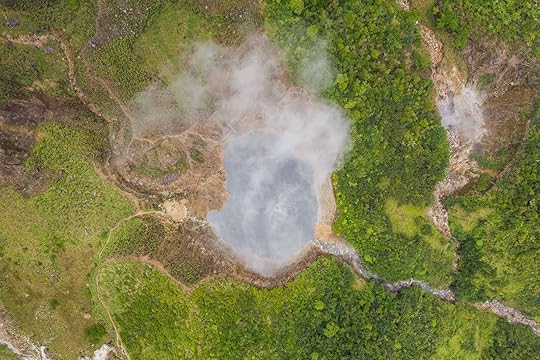
Photo: JibiBrown/Shutterstock
Dominica has nine volcanoes, hence the black sand that blankets its shores. Geothermal water simmers from below the surface of Morne Trois Pitons National Park — the first and largest of Dominica’s three national parks — forming steaming sulfur pools.
Along the winding road that cuts through Morne Trois Pitons, I stopped to see bubbling pools of mud too hot to soak in, billowing steam on the sides of hiking trails and below viewing platforms that put me within noseshot of the eye-watering sulfur smell. The stench is worth enduring to witness Dominica’s volcanic landscape in action.
Some springs are safe to soak in, like the human-made baths at Wotton Waven Hot Springs and Ti Kwen Glo Cho, both quiet and surrounded by nature. At the latter, I took a mid-road-trip dip in 100-degree, coffee-colored mineral water alongside locals. You won’t see this place overrun by tourists, especially when there isn’t a cruise ship visiting the island.
Ti Kwen Glo Cho: 8M87+799, Wotten Waven, Dominica
Sample bush rum in the jungle
Photos: Olivia Young
Bush rum refers broadly to locally produced, homestyle rum that can be found in the Caribbean. It was traditionally distilled in small batches — typically in remote locations outside of official distilleries, hence the name — and often infused with wild herbs, fruits, and spices.
It isn’t unusual to find a bush-rum bar in the Dominican wilderness. I found them in the least expected places — like along a trail that leads to a watering hole and right on the Indian River, which I had to get to by boat. At one positioned along the walk to Ti Kwen Glo Cho, I let the bartender talk me into a shot of the “all-purpose” flavor, which she poured from a hand-labeled glass jug of liquid, leaves, and twigs. Other bush bars featured funky infusions like tobacco, bitterwood, and marijuana, but my favorite — as someone with an unsophisticated palate for the Caribbean spirit — was cinnamon, which tastes like Goldschläger if it were brewed in the jungle.
Learn about the Indigenous Kalinago
Photos: Fabio Mauri/Shutterstockand Olivia Young
The Kalinago were the first people to call Dominica home as long ago as 3000 BCE. There are still about 3,000 of them living in the protected Kalinago Territory on the island’s northeast coast, and they invite tourists to learn about their history and culture on walking tours led by Indigenous guides who live there.
The official tour starts and ends inside of a model village where Kalinago vendors sell souvenirs in thatched-roof huts. Along the way, the guide pauses to soak in a particularly magical scene where a waterfall cascades into the ocean and to explain how native herbs along the path are used as medicine, how bush plants are formed into ancestral arts and crafts. In one of their most fascinating practices, the Kalinago will bury tree ferns in the ground until they become black and bark-like, then carve them into totems. The tour ends at a stand of these figures, each carved with the face of a former Kalinago chief and looking out over the sea.
Where to eat and drink in DominicaKeepin’ It RealThis beach restaurant right on the sand in Toucari is an essential stop for seafood eaters. It serves traditional Dominican plates of rice, beans, fried plantains, taro, and provision — a local staple made of mashed root vegetables — with the protein options of the day. Fresh catches might include mahi mahi, lobster, and shrimp. It’s best to call this popular haunt ahead with your order.
Keepin’ It Real: Toucari Beach, Toucari, Dominica
Jungle Bay
Photo: Olivia Young
For a fresher version of the classic Dominican plate, snag a table at Jungle Bay. This resort sits on expansive gardens of tropical fruit trees and offers a higher-elevation view that looks directly over the world’s first sperm whale reserve, which covers 304 square miles off the west coast. As a vegan, I was glad to find not just the island’s signature rice-and-bean dish served in Jungle Bay’s open-air restaurant but also a menu brimming with vegetable wraps, Buddha bowls, salads, and tofu dishes. Then again, there’s no shortage of plant food anywhere in Dominica.
Jungle Bay: Morne Acouma, Soufriere, Dominica
The Roseau Farmer’s MarketWhen in the capital on a Saturday, peruse the produce-packed stands at Old Market Square, Roseau’s historical centerpiece. Even visitors who don’t have the amenities to cook in their hotel rooms can pick up tropical fruits to snack on like papaya, pineapple, and passionfruit.
Roseau Farmer’s Market: Old Market Square, Roseau, Dominica
Where to stay in DominicaFor diving: Fort Young Hotel and Dive Resort
Photo: Fort Young Hotel and Dive Resort
In Roseau, Fort Young is a sprawling resort housed in an 18th-century military fort on the Caribbean Sea. It offers everything needed for a dive trip: accommodations, two dive boats, a pool deck, bars, and a restaurant that serves a themed buffet — such as Mediterranean or Asian food — every Saturday. There’s even the option to dive right off of the hotel’s jetty.
Behind its original stone walls, guests will discover all sorts of treasures, from a prison-cell-turned-rum-cellar to an art gallery showcasing Dominican art. The rooms are split between the original building and a newer, taller addition, and many accommodations have balconies overlooking the water. On drizzly days, step out of the sliding glass door to look for rainbows on the horizon.
Fort Young Hotel and Dive Resort: Victoria Street, Roseau, Dominica
For ultimate luxury: Secret Bay
Photo: Secret Bay
A collection of 23 villas sprinkled across 50 acres of untouched jungle on the island’s northwest shore, Secret Bay is the epitome of Caribbean luxury. From these private hideaways — each with its own infinity pool — guests can travel by golf cart or funicular to the Welcome House, a communal space where they can convene in the shared pool, relax on a black-sand beach, or have a four-course meal on the patio of Bwa Den. A short walk or golf cart ride from the Welcome Center, there’s a yoga platform where an instructor leads private sessions surrounded by nature. Guests can also walk a trail to the chef’s herb- and tropical-fruit-filled garden, where they can take a cooking class with the chef at Botanica, the outdoor kitchen.
Secret Bay: Portsmouth, Dominica
For a green getaway: Sea Cliff Eco-CottagesSolitude is staying in an eco-cottage on the cliffs of Calibishie, a village on Dominica’s northeast coast. It’s so peaceful on this hill that the cottages often play host to reading retreats and writing workshops. It’s the perfect place to clear the mind — and indulge in a tipple. The couple who runs Sea Cliff, expats from the UK and US, distill gin in creative Dominican flavors on the property.
Sea Cliff Eco-Cottages: Point Dubique, Calibishie, Dominica
Getting to and around Dominica
Photo: Olivia Young
Dominica has two international airports: Douglas-Charles (DOM) on the northeast coast and Canefield (DCF) on the west coast, just north of Roseau. Douglas-Charles is the larger airport though it has only one terminal. A new, bigger airport near Douglas-Charles is expected to welcome flights in 2027, but until then, US travelers can fly direct to Dominica via an American Airlines flight from Miami and a new United Airlines route between Newark Liberty and Douglas-Charles that debuted in February. Both run at least once a week.
There’s a bounty of regional island hoppers offering layovers on nearby Caribbean islands, as well. Plan to stop over in Sint-Maarten, for example, and spend your layover watching planes fly alarmingly close to the shore at the famous Maho Beach, a half-mile walk from Princess Juliana International Airport.
When you’re exploring the island, Dominica is best navigated by car. Taxis are easy to find, but visitors also rent cars. Some things for prospective car-renters to consider: Dominicans drive on the left side of the road. The roads can be rough, windy, narrow, and steep — there are no flat and easy freeways crossing the island. 
The Best Hotels Near Seattle’s Lumen Field for Soccer Fans

Seattle’s Lumen Field is heading into two historic years of global soccer, with international heavyweights like Paris Saint-Germain and Atlético de Madrid coming to town for the 2025 FIFA Club World Cup — followed by six packed-out fixtures during the 2026 FIFA World Cup, including two knockout games and a key group-stage match for the USMNT on June 19. With that much action on the calendar, hotels near the stadium — especially those within walking distance — are expected to fill quickly.
If you’re traveling in for a match, staying near the stadium makes logistics a whole lot easier. Lumen Field sits just south of downtown in the SoDo neighborhood, right next to Pioneer Square and a short walk from the waterfront. The light rail runs from the airport straight to Stadium Station, just a few minutes from the gates, and Amtrak trains arrive at King Street Station, located directly across the street from the stadium.
There’s a wide range of hotels within walking distance, from upscale waterfront stays to more affordable downtown options. Some hotels are expected to run game-day shuttles, but it’s best to confirm directly with the property when booking.
Whether you’re catching a Club World Cup fixture this summer or planning ahead for the World Cup in 2026, these are the best hotels near Lumen Field for staying close to the action.
We hope you love the hotels near Lumen Field we recommend! Just so you know, Matador may collect a small commission from the links on this page if you decide to book a stay. Listed prices are accurate as of the time of publication.
The best hotels near hotels near Lumen FieldcitizenM Seattle Pioneer Square
Photo: Booking
Location: 60 Yesler Wy, SeattleHow far from the stadium: 10-minute walkPrice: From $235 per nightA 10-minute walk from Lumen Field, citizenM puts you in the middle of Seattle’s most historic neighborhood — Pioneer Square — known for its century-old architecture, independent galleries, and a growing collection of craft coffee spots and casual eateries. The hotel follows the citizenM model: one room type only, with king-size beds, blackout blinds, and smart tech that lets you control lighting, blinds, and streaming from a tablet. Rooms are small but efficient, with large windows that provide ample natural light and soundproofing that will help when the streets below fill up on matchdays. Downstairs, the communal “living room” is part co-working space, part bar, and part art gallery, with 24/7 drinks and food on offer. There’s no on-site parking, but the light rail and Amtrak stations are both just a few blocks away.
BookCourtyard Seattle Downtown
Photo: Booking
Location: 612 2nd Ave, SeattleHow far from the stadium: 10-minute walkPrice: From $223 per nightA few blocks from citizenM, Courtyard Seattle Downtown is housed in the early-1900s Alaska Building, one of Seattle’s original high-rises and a defining feature of Pioneer Square’s architectural mix. It’s a 10-minute walk to Lumen Field, with rooms that feel geared toward longer stays — many include a mini-fridge and coffeemaker, and several offer views across downtown or out toward the bay. You’re within walking distance of the waterfront, the stadiums, and a cluster of bars and restaurants that make this one of the city’s livelier neighborhoods. Downstairs, The Bistro serves Starbucks coffee and breakfast in the mornings, with cocktails and casual dinner options later in the day.
BookCrowne Plaza Seattle
Photo: Booking
Location: 1113 6th Ave, SeattleHow far from the stadium: 20-minute walkPrice: From $140 per nightAbout a 20-minute walk from Lumen Field, the four-star Crowne Plaza puts you in the downtown core, with quick access to the stadium, the waterfront, and the city’s biggest landmarks, including Pike Place Market and the Seattle Art Museum. Rooms are comfortable and functional, with floor-to-ceiling windows in many and higher floors offering partial bay views. The on-site Elevation Restaurant is more ambitious than most downtown hotel dining — dishes range from Dungeness crab quesadillas and Beecher’s cheese poutine to pan-seared salmon and house-made hollandaise breakfasts. You’ll also have access to a fitness center and meeting space, with a location that works well whether you’re walking to matches or heading further into the city.
BookEmbassy Suites By Hilton Seattle Downtown Pioneer Square
Photo: Booking
Location: 255 S King St, SeattleHow far from the stadium: Three-minute walkPrice: From $249 per nightAnother reliable option in Pioneer Square, Embassy Suites is one of the closest hotels to Lumen Field — you can get from the front door to the stadium in under five minutes. The location is particularly useful if you’re arriving by train, with King Street Station and Union Station both within a block. Room types vary, but many include separate living areas with sleeper sofas, which works well if you’re traveling with others or planning a longer stay. Breakfast is made-to-order and included, and there’s also an indoor pool, Peloton bikes in the gym, and a sleek lobby lounge where you can grab a drink or small plate. For a proper sit-down meal, 13 Coins — a late-night favorite among Seattle locals — is connected to the building and serves everything from prime rib dip and veal marsala to seafood pasta and grilled salmon. If you want to be right next to the action, this is one of the more practical options near the stadium.
BookFour Seasons Hotel Seattle
Photo: Booking
Location: 99 Union St, SeattleHow far from the stadium: 20-minute walkPrice: From $797 per nightIf you’re going all-in for the World Cup, this is where to do it. A 20-minute walk from Lumen Field, the Four Seasons puts you between Pike Place Market and the waterfront, with views across Elliott Bay and the Olympic Mountains from many rooms. The design uses natural materials — wood, stone, and original Pacific Northwest artwork — to ground the space in a strong sense of place. The rooftop infinity pool is a rarity in Seattle, and on clear summer days it’s one of the most photogenic spots in the city. Downstairs, Goldfinch Tavern serves refined takes on local seafood. There’s also a full-service spa, in-room espresso-themed treatments, and a “coffee concierge” who’ll bring a fresh cup to your door before you even leave bed. If you want your matchday to begin with a eucalyptus steam and end with Dungeness crab and a view, this is the one to book.
BookHilton Motif Seattle
Photo: Booking
Location: 1415 5th Ave, SeattleHow far from the stadium: 25-minute walkPrice: From $226 per nightAbout a 25-minute walk from Lumen Field, Hilton Motif sits near the edge of downtown’s commercial core, close to Pike Place Market and the Seattle Art Museum. You’re high enough here for water views in some rooms, and the rooftop restaurant — Frolik Kitchen & Cocktails — makes the most of that elevation with one of the best skyline-facing patios in the city. The menu features seafood and small plates alongside cocktails and a well-curated selection of Washington wines. Rooms are bright and comfortable, with larger suites offering separate lounge areas. If catching a sunset with a cocktail sounds like your kind of pre-game, Motif is worth a look — or at least stop by the patio as a guest if you’re staying elsewhere.
BookHyatt at Olive 8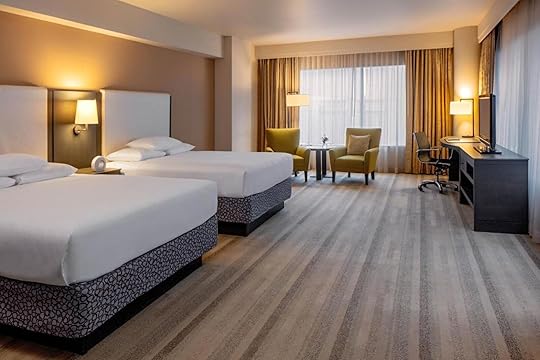
Photo: Booking
Location: 1635 8th Ave, SeattleHow far from the stadium: 30-minute walkPrice: From $264 per nightHyatt at Olive 8 was Seattle’s first LEED-certified hotel, and that attention to detail carries through everything from the spa treatments made with Pacific Northwest botanicals to the in-room energy-efficient systems and natural materials. The saltwater lap pool sits alongside a steam room, hot tub, and one of the better hotel gyms downtown. Upstairs, rooms feel crisp and unpretentious, with big desks, soaking tubs in some suites, and blackout curtains for anyone catching up on rest between matches. TIDAL+, the on-site restaurant, focuses on local seafood with thoughtful pairings and a well-edited cocktail menu. Capitol Hill is just a few blocks up — which means late-night ramen or a nightcap on Broadway is still within reach before you crash.
BookLotte Hotel Seattle
Photo: Booking
Location: 809 5th Ave, SeattleHow far from the stadium: 15-minute walkPrice: From $530 per nightJust 15 minutes on foot from Lumen Field, Lotte brings a different kind of energy to the downtown hotel scene — grand, theatrical, and unapologetically luxe. Set across the gleaming F5 Tower and a restored 1907 church (now an event space), the interiors showcase Philippe Starck’s dramatic style — the famed French designer known for his bold, avant-garde spaces — with marble bathrooms and panoramic bay views that amplify the hotel’s theatrical feel. You’ll find five-star details throughout, from the 16-head spa showers at Le Spa de l’hôtel Lotte to a baby grand piano in the top-floor suite. Dining at Charlotte, the 16th-floor restaurant and lounge, stays firmly in fine-dining territory — seafood towers, porterhouse steaks, and a cocktail menu that includes a signature drink inspired by the Seattle Sounders. For fans coming to town for a big match and looking to turn it into something celebratory, this hotel delivers across the board.
BookSilver Cloud Hotel — Seattle Stadium
Photo: Booking
Location: 1046 1st Ave S, SeattleHow far from the stadium: Three-minute walkPrice: From $199 per nightThe rooftop pool at Silver Cloud overlooks the stadium — a reminder that you’re in prime position for World Cup matches. The three-star sits three minutes from Lumen Field, with a location that also puts you near the ferry terminal, waterfront, and Pioneer Square. Rooms are functional and clean, with microwaves and mini-fridges standard, and complimentary laundry access — a useful extra if you’re catching multiple fixtures. The rooftop pool overlooks both ballparks, and Jimmy’s On First, the in-house sports bar, fills fast on matchdays with fans trading predictions over beers and big-plate mains like ribeyes and mac and cheese. You’ll want to book this one early — it’s built for fans, and it’s likely to be full of them.
BookSonder RailSpur Apartments Pioneer Square
Photo: Booking
Location: 417 Occidental Ave S, SeattleHow far from the stadium: Five-minute walkPrice: From $176 per nightSet in a restored brick building in Pioneer Square, this apartment-style stay trades traditional hotel layouts for compact lofts with clever design details, including kitchenettes and space to work if you’re extending your trip. Most units come with elevated beds accessed by ladders — not ideal if you’ve had a few too many drinks after a fixture, but great for anyone who doesn’t mind a little climbing. The rooftop is stunning, with views over the neighborhood and the stadium cranes, and there’s plenty to do nearby: Taylor Shellfish is across the street, the galleries and indie shops of Occidental Square are around the corner, and the Seattle waterfront is less than a 10-minute stroll away.
BookThe Alexis Royal Sonesta Hotel Seattle
Photo: Booking
Location: 1007 1st Ave, SeattleHow far from the stadium: 15-minute walkPrice: From $269 per nightWalking to Lumen Field in about 15 minutes is reason enough to consider The Alexis, but the real standout here is how much character this place packs into its century-old bones. Set on 1st Avenue in the heart of downtown, it’s just a few blocks from Pike Place and the waterfront — a central spot that still feels a little more neighborhood than business district. Rooms mix vintage touches like exposed brick with smart tech perks (each comes with an Amazon Echo), and the hotel gym is no afterthought — there’s a rock-climbing wall, monkey bars, and a Peloton, which feels on-brand in a city obsessed with both startups and the outdoors. You could make a whole evening out of just hanging at The Bookstore Bar & Café, where shelves of novels back the bar, and the whiskey list includes rarities you’ll struggle to find elsewhere. Add in on-site shops, a salon, and some of the most personal service downtown, and it’s the kind of place that turns your World Cup trip into a Seattle experience you’ll actually remember. 
May 20, 2025
Green by the Sea: How BC’s Capital Is Leading Small Cities in Sustainable Tourism

On only one occasion have I been inclined to ask a restaurant’s waitstaff about the music playing inside the establishment. That occasion was in January 2025 at End Dive, a dimly-lit corner establishment in downtown Victoria, British Columbia, and the reason for my inquiry was because I couldn’t believe what I was hearing – ‘90s-era punk rock, the soundtrack to a generation of youth rebellion I aligned with as a teenager and that first showed me a school of thought beyond that of my cookie-cutter suburban childhood.
“The band is called Chixdiggit,” our waitress informed me, after checking with the heavily tattooed bartender.
I was in town with a group of writers attending the IMPACT Sustainability + Travel Conference, and though I appreciated the tunes, we’d chosen End Dive for dinner this particular evening because of its rigid mantra of local sourcing. Tabletop candles duskly lit a veggie-heavy menu derived almost entirely of ingredients grown on Vancouver Island, coupled with a wine and beer list that pushed that limit as far as the Okanagan Valley. For two hours we chatted over hors d’oeuvres and small-plate mains as fresh as the salty Salish air. The playlist was a bonus, at least in my view, and it echoed a statement the restaurant had already made loud and clear – authenticity is everything. Over six days in Victoria, this same ethos would prove itself over and over again, from our accommodations to our experiences with local businesses, and it’s the reason Victoria is leading among mid-size cities in sustainable tourism.
Across the city, sustainability starts at the dinner table – and en route to it
More than 20 miles of protected bike lanes stretch across Victoria. Photo: Tim Wenger
Victoria’s interconnected network of protected bike lanes spiderwebs through the city and into neighboring suburbs, totaling more than 20 miles within city limits. Through this network it’s possible to pedal to the vast majority of the city’s 260-some restaurants, 82 percent of which are independently owned. Eating locally-sourced, low-impact food is easy even beyond End Dive – Virtuous Pie serves up delicious vegan pizzas with local flavors (followed by the best ice cream sandwich I’ve had), WhistleBuoy Brewing Company pours beers made largely from ingredients grown in the Pacific Northwest. What unites many of the city’s food and drink hubs is a commitment to sourcing local and keeping the end product out of landfills. Food waste is a massive problem – the US wastes over 100 billion pounds of food each year, some 40 percent of its supply by some estimates. This issue is even more pervasive in Canada, where nearly 50 percent of food produced goes to waste.
Hotels, particularly large ones that frequently host events like weddings and business functions, contribute heavily to this problem. Solutions are coming forth – Populus, in Denver, installed an on-site bio-digester to compost all food waste onsite, for example. Our group stayed at Fairmont Empress, in Victoria’s Inner Harbour, where the conference took place. Under the direction of Executive Chef Isabel Chung, the Fairmont Empress in downtown Victoria is embracing newer technology to tackle food waste. Its AI-driven Orbisk food waste monitoring system uses image recognition and weighing scales to automatically track and analyze every instance of food discarded in the kitchen. The system collects detailed data on the type, quantity, and timing of waste, providing Chef Chung and her team with real-time, actionable insights.
“Sustainability is a core value in my approach,” Chung said in a recent press release. “I always strive to incorporate sustainable practices to do my part in helping create a healthier planet for future generations.”
By leveraging these AI-driven insights, the team can make immediate corrections in the kitchen, educate staff on production needs by identifying what is going to waste and why, and ultimately minimize overproduction and surplus. The results are impressive: similar systems in other Fairmont and Accor hotels have achieved food waste reductions of up to 39%, nearly in line with the company’s goal of halving food waste by 2030. The best way to experience this for yourself is to dine at Q at The Empress, the hotel’s posh restaurant that specializes in locally-sourced seafood paired with veggies grown on the island.

Q at The Empress specializes in fresh, local seafood. Everything on this plate was sourced locally, with sourcing traceable via QR code on our custom-made menu. Photo: Tim Wenger
This technology is only part of the hotel’s mission to reduce its impact. The Empress earned the prestigious BIOSPHERE© Certification from the Responsible Tourism Institute. This certification recognizes public, transparent efforts toward sustainability and aligns with the United Nations’ 2030 Agenda, including its 17 Sustainable Development Goals (SDGs). In addition, the hotel has earned a 4 Green Key Certification.
These accolades are no small achievement for a hotel with over a century of history. Commissioned by the Canadian Pacific Railway and designed by architect Francis Rattenbury, the hotel officially opened its doors on January 20, 1908. The Empress was envisioned as a grand chateau-style hotel to serve affluent railway and steamship travelers, and its name pays homage to Queen Victoria, who was also Empress of India during the final decade of her reign. It was designated a National Historic Site of Canada in 1981, and its most recent $60 million renovation completed in 2017. The Castle on the Coast, as its known locally, isn’t cheap – rooms here often run north of $300 per night – but for that spend an eco-conscious guest can rest easier knowing their travel dollar is in good hands.
Victoria is a hub for sustainability innovators
FED Urban Farm grows veggies for local restaurants and CSA customers. Big Wheel Burger returns compost to the farm. Photo: Tim Wenger
There are countless grassroots developments taking root in Victoria as well, often led by women and Indigenous creators. Inside a collective of maker businesses, Meaghan McDonald operates Salt Legacy, upselling used sailcloths into handbags, purses, and backpacks. Inside downtown’s Bay Centre mall, Market Collective – led by local artists and entrepreneurs Katrina Dwulit, Vanessa Gaudet, and Cory Judge – highlights local makers and artists by providing a central place to display and sell their work. A few miles away, Sarah Rhudey and partners do the same for Indigenous artists and makers at Aunty Collective.
With enough dedication and support these efforts can reach scale. Such is the case with Big Wheel Burger, which claims to be the first carbon-neutral fast food chain in Canada. Beef, of course, is notoriously high-emissions – the company rigorously measures its greenhouse gas and methane emissions and offsets what it cannot reduce through verified projects like the Great Bear Forest Carbon Project, supporting both climate action and First Nations communities. During the Day of Impact preceding the conference, I had a crispy chickpea burger and it was full of flavor, far from the bland yet all-too-common frozen veggie burger patty offered by casual spots as the vegetarian option.
Big Wheel Burger’s takeout containers are compostable, and the company buys its vegetables from Victoria’s FED Urban Farm and then returns its compost back to the organization for circularity. It is also the first restaurant in North America to achieve Biosphere Certification, thanks in part to its efforts to recycle used cooking oil into biodiesel and handle deliveries with an electric van.

Salt Legacy upcycles used sailcloths into bags and more. Photo: Tim Wenger
As part of the conference’s Day of Impact, we boarded a whale watching boat operated by local outfitter Prince of Whales and departed Victoria Harbour to tour the Upper Harbour channel and then head out into the Salish Sea to sightsee. On this overcast January day, the dark blue water of the channel was lightly translucent, allowing us just occasional views of the dynamic estuarine ecosystem here that supports a diverse array of aquatic life. This area, including the adjacent Gorge Waterway, is characterized by tidal estuaries, intertidal mudflats, and abundant eelgrass beds. 30 years ago, however, life of any type was hard to find in the channel, thanks to decades of coal gasification, tanneries, sawmills, and shipbuilding operations.
Starting in the 1990s, local volunteers, notably the Veins of Life Watershed Society, began removing debris and garbage from the water and shoreline, inspiring broader community involvement and regular cleanups by local groups, businesses, and government agencies. The city of Victoria implemented effective regional source control programs to restrict pollutants entering the waterway from sewers and storm drains, addressing the legacy of industrial and sewage pollution that had resulted in the disheveled state of the Gorge. Habitat restoration projects, environmental education, and public outreach further supported the recovery of the waterway’s ecosystem, and the results are tangible.
“No one would swim in the gorge 10 years ago,” Nik Coutinho, Sales & Marketing Director for Prince of Whales, told our group. “Now, on a summer day you’ll see 1,000 people swimming.”
My favorite thing about traveling to Victoria, and British Columbia more broadly, isn’t the good urbanism, stunning coastal mountains and inlets, or the unmatchable friendliness, but the fact that I know this is a place where maintaining my values while traveling is easy to do. That’s because we share similar values – of doing right by the planet and people. Of low-impact eating and high-octane adventuring. And a common belief that we can strive to be better and do better each day. While in Victoria, a friend back home in Colorado texted with an invite to ski, and upon learning where I was replied, “Ah, BC, you’re second home.” I may never be so blessed, but I will return every chance I get. 
The Best Hotels Near Boston’s Gillette Stadium for Soccer Fans

Like the Olympic Games, the FIFA World Cup — the biggest soccer tournament in the world — is held every four years in a new host country each time. In 2026, it will take place throughout North America, i.e. in the US, Canada, and Mexico, but the US will host more games than the other two nations. Among the 11 US cities welcoming players and fans for the sporting event, is Boston. A total of seven matches will take place in Boston’s Gillette Stadium during the 39-day tournament.
If you’re keen to see as many of the matches as possible between the kick-off game on June 11, 2026 and the final on July 19, 2026 — and potentially see USMNT win some — you need to plan ahead. And that means purchasing tickets for the matches and booking suitable hotels where to prep and where to crash afterwards. The following hotels near the Gillette Stadium are the ones you should be looking for the summer of 2026’s biggest sporting event.
We hope you love the hotels near the Gillette Stadium we recommend! Just so you know, Matador may collect a small commission from the links on this page if you decide to book a stay. Listed prices are accurate as of the time of publication.
The best hotels near the Gillette StadiumRenaissance Boston Patriot Place Hotel
Photo: Booking
Location: 28 Patriot Pl, FoxboroughHow far from the stadium: Three-minute walkPrice: From $179 per nightThis Marriott property is the closest you can stay to Boston’s Gillette Stadium. The three-minute walk between the two means you won’t have to find a place to park on game day, and you won’t have to battle the crowds before and after matches on public transport. But location isn’t this hotel’s only asset.
The Renaissance Boston Patriot Place Hotel offers a choice of four types of rooms, all newly renovated and decorated in the same modern style. The range of rooms can accommodate between one and four people in queen-size and king-size beds. If you want to keep an eye on Gillette Stadium at all times, request a room with a view — you won’t be disappointed.
The only on-site restaurant, Twenty8 Food & Spirits, serves American-style cuisine. But if you’re looking for something different, you won’t have to stray far. There are plenty of food and drink options within walking distance — ranging from casual to sophisticated — including Mexican and Italian restaurants, a seafood-focused venue, and several bars where you can meet fellow sports fans.
Like any modern property worth its salt, the Renaissance Boston Patriot Place Hotel is home to a fitness center equipped with everything you need to stay in shape. But the best part is the beautiful indoor heated saltwater pool and its plush seating, where you can relax after swimming a few laps.
And in case you’re wondering — yes, this hotel is named after the New England Patriots, since Gillette Stadium is the team’s home. As such, it knows how to make sports fans feel welcome.
BookHotels near the stadium within a short driveCourtyard by Marriott Boston Norwood
Photo: Booking
Location: 300 River Ridge Dr, NorwoodHow far from the stadium: 13-minute drivePrice: From $123 per nightJust outside Boston’s city limits, the town of Norwood is a convenient place to stay if you’re coming in for a FIFA World Cup match. While it’s not within walking distance of Gillette Stadium, it’s just a short drive — less than 15 minutes. Because it’s slightly farther from the center of the action, it’s also more affordable.
This Courtyard by Marriott property offers comfortable rooms that accommodate between one and five guests. All rooms are furnished with queen- or king-size beds, with larger rooms featuring a sofa bed and desk. Accessible rooms are available.
The on-site restaurant, The Bistro, is open daily and serves American fare and Starbucks coffee. There are also casual food and drink options nearby, including Conrad’s, where you can catch all the sports you want on multiple HD TVs.
The property features a fitness center with weight machines, treadmills, and exercise bikes — perfect for a workout before heading to the stadium.
BookFairfield Inn & Suites by Marriott Boston Walpole
Photo: Booking
Location: 630 Providence Hwy, WalpoleHow far from the stadium: 10-minute drivePrice: From $123 per nightJust 10 minutes from Gillette Stadium by car, the Fairfield Inn & Suites is a modern, practical, and affordable place to stay — especially if you’ve already emptied most of your savings on FIFA World Cup tickets. And this property offers even more than just a great location and price.
There are three types of rooms and suites at this Marriott property, all furnished with either queen-size or king-size beds, along with 55-inch smart TVs and desks for guests who need to get some remote work done. Each room type also has accessible options. The suites can accommodate up to four guests.
There’s no restaurant or bar, but you can stock up on snacks and cold drinks at The Corner Market, the on-site convenience store, which is open 24 hours a day.
For guests on a budget, it’s worth noting that the buffet breakfast is included, along with access to the 24/7 fitness room and indoor pool.
BookHome2 Suites By Hilton Boston Franklin
Photo: Booking
Location: 725 Union St, FranklinHow far from the stadium: 20-minute drivePrice: From $110 per nightThough well outside the city, Home2 Suites is just 15 minutes by car from Gillette Stadium. It’s not only very affordable but also offers complimentary parking, free breakfast, and allows pets for an additional fee.
There’s a wide variety of suites available, including accessible options, and all are equipped with a kitchen and a sofa bed. The suites accommodate up to four guests. Though the rooms share a similar layout, they’re colorful and fun, featuring pink couches, yellow beds, and bright armchairs that add a cheerful touch to your stay.
Guests can take advantage of a small fitness center, an indoor saltwater pool, and laundry machines — handy for anyone who may have packed a little too light.
While there’s no bar or restaurant on-site, the Home2 Market offers snacks and cold drinks.
BookSheraton Boston Needham Hotel
Photo: Booking
Location: 100 Cabot St, NeedhamHow far from the stadium: 20-minute drivePrice: From $169 per nightClose to the city yet about 30 minutes by car from Gillette Stadium, this recently renovated Sheraton property offers rooms and suites that can accommodate up to five guests. The rooms feature traditional decor, and the accommodations are cozy, comfortable, and spacious.
The Sheraton Boston Needham Hotel has everything you’d expect from a modern property: a well-equipped fitness center, a restaurant-bar, and a beautiful heated indoor pool. Pets are welcome in case you can’t part with your four-legged friend.
There’s a host of casual food and drink options nearby, including several Chinese and Italian restaurants, along with a few local pubs. The Biltmore Bar & Grille, located less than a mile away, is a great spot for cocktails before or after the match.
BookSpringHill Suites By Marriott Wrentham Plainville
Photo: Booking
Location: 65 Ledgeview Wy, WrenthamHow far from the stadium: 9-minute drivePrice: From $150 per nightJust an eight-minute drive from Gillette Stadium, this Marriott property is a modern, all-suite hotel packed with amenities, including a well-equipped gym and a heated indoor pool — both complimentary.
The light-filled suites all feature modern decor and elegant furnishings, including queen-size and king-size beds, desks, and trundle beds. The largest suite can accommodate up to five guests — perfect for those traveling with their soccer-loving friends.
While there’s no restaurant on-site, there is a bar serving beer, wine, and cocktails. You’ll also find a variety of restaurants and bars nearby, including two sports pubs where you can meet fellow fans. If you’re looking for something a bit more upscale, Tavolino — an Italian restaurant just four miles away — delivers.
Breakfast at this property is complimentary, and snacks and drinks are available for purchase at the on-site mini market.
BookHotels near the South Station, BostonClub Quarters Hotel Faneuil Hall
Photo: Booking
Location: 161 Devonshire St, BostonHow far from the stadium: One-hour on public transportationPrice: From $209 per nightClub Quarters Hotel Faneuil Hall is 10 minutes from South Station, where you can catch a one-hour T ride to Gillette Stadium. While it’s less convenient than staying near the stadium, this centrally located property allows you to explore the city on foot — from walking the Freedom Trail and visiting Boston Common (the oldest city park in the US) to touring the historic Faneuil Hall Marketplace.
Club Quarters offers five types of rooms, the largest of which is the one-room suite, which can accommodate up to four guests. All rooms are modern and elegant, featuring desks and TVs, and some even have kitchenettes.
On the ground floor of the hotel is Elephant & Castle, the on-site British pub where you can have a drink (beer, most likely) and enjoy traditional pub fare like fish and chips, shepherd’s pie, and more. You can even order room service if that’s more your speed. The pub also serves breakfast.
While there’s no fitness center or pool at this property, you’ll likely be too busy exploring the city to even notice.
BookInterContinental Boston by IHG
Photo: Booking
Location: 510 Atlantic Ave, BostonHow far from the stadium: One-hour on public transportationPrice: From $360 per nightThis IHG property isn’t close to Gillette Stadium, but that doesn’t mean it’s hard to reach. The hotel is just four minutes from South Station, where you can hop on a T train for the one-hour-plus ride to the stadium. While that might seem like a long way to go to catch a game, the hotel’s location more than makes up for the time spent on the train — Boston’s waterfront is unbeatable.
Not only can you enjoy views of the Fort Point Channel from the floor-to-ceiling windows of your room or suite, but you’ll also be within walking distance of the USS Constitution and the Boston Tea Party Museum — two of the city’s must-sees.
The rooms and suites at the InterContinental Boston by IHG have been recently renovated with marble baths and elegant furnishings. At 3,200 square feet, the Presidential Suite is the largest room type available, featuring one king-size bed, two queen-size beds, a dining room, and a sitting room with a fireplace. Of course, the Classic Rooms are great too, just a bit smaller at 420 square feet.
As an upscale property, it also features a fitness center (equipped with Peloton bikes), a heated indoor pool, and a spa. Book a facial or massage and take advantage of the sauna before or after catching a FIFA match.
The on-site restaurant, Matria, is open for breakfast, brunch, lunch, and dinner. Its seasonal terrace is a great spot to enjoy Italian fare with a view of the Seaport. For drinks, guests can choose from three options: the stylish Bar Fellini, the secretive and speakeasy-like Loyall Counting Room, or the seasonal and outdoor 501 On The Waterfront.
BookThe Langham, Boston
Photo: Booking
Location: 250 Franklin St, BostonHow far from the stadium: One-hour on public transportationPrice: From $495 per nightThere are no two ways about it: If you want a luxury experience during your time in Boston, you need to stay in the city center — not near the stadium. And yes, even if the main reason for your visit is to catch a FIFA World Cup match, it’s well worth it.
The Langham, a five-star, two-Michelin-Key property, is a 30-minute ride by car from the stadium (or just over an hour by train), but it’s one of the most beautiful hotels in the city. The sophisticated, light-filled rooms and suites might even make you think twice about leaving the premises.
The 1,100-square-foot Two-Bedroom Suite is the largest room type available, but unless you’re traveling with a group, all you’ll need is a cozy yet elegant Park View Club Room. No matter which of the many room types you choose, you’ll enjoy gorgeous furnishings and classic New England decor.
The wellness facilities include a gym with state-of-the-art equipment, a 40-foot indoor pool, a hot tub, and several saunas — perfect for unwinding after the match.
On-site food and drink venues include Grana, a stylish family restaurant, and The Fed, a newly redesigned cocktail pub — both chic and inviting. 
These Downtown Spokane Hotels Let You Charge to Your Room — No Matter Which One You Book

I hadn’t been to Spokane, Washington, since college, when I visited a friend enrolled at Gonzaga. As 19-year-olds, we spent our time drinking beer from red Solo cups, eating at Pita Pit, and searching for the best weekend parties on campus. In stark contrast to that weekend was the luxury experience that Davenport Hotels recently curated for me. Over the course of a long weekend, it included special menus that served as a preview of the city’s inaugural Pacific Northwest Food & Wine Festival coming this fall, relaxing spa treatments, local wine tastings, cooking classes, and a chance to explore all that Spokane has to offer.
Davenport Hotels comprises five luxury hotels in Spokane: The Davenport Hotel, The Davenport Grand, The Davenport Tower, The Centennial, and the latest addition to the group, The Louie. Four of those properties are located in the downtown area and belong to Marriott’s Autograph Collection — all but The Centennial — meaning that guests staying at any one of those four have access to the other hotels’ amenities and can charge to their room.
I was based at The Davenport Hotel, but a stay with Davenport Hotels isn’t your regular hotel experience — it’s part of an ecosystem of properties that serve as the foundation for an exciting weekend spent exploring a city full of dining, art, history, and outdoor experiences. All outlets (13 restaurants, the Davenport Spa, and all shops) are also open to the public.
Inside the historic Davenport Hotel
Photos: Hayden Seder
At the heart of this group of hotels is Spokane’s most iconic hotel and the namesake of the hotel system: The Davenport Hotel. Walking through The Davenport feels like being transported to Europe’s lavish churches and castles, which was the intention when the hotel’s developer, Louie Davenport, enlisted local architect Kirtland Cutter to design the hotel in 1914. The first floor of the hotel is an ode to some of Europe’s most opulent architecture, with vaulted ceilings adorned with wood-like carvings, ornately designed with historic crests from across the world and images of animals, faces, and flowers.
To take in all the history, architectural details, and hidden Easter eggs, I took a tour led by resident historian Scott (tours are every Wednesday at 6 PM or by request) who in his waistcoat, page boy cap, and chained pocket watch fit the bill for a man about to divulge the hotel’s various secrets and ghost stories. Scott was a delight, playing a different queued up song for each of the hotel’s many geographically themed ballrooms (Spain, Italy, London, and France), showing us the embedded footprints in the first-floor marble floors from employees standing in the same spot for years, and pointing out how the bronze statue of Louie Davenport by the hotel’s entrance has had so many people stick their fingers in its eyeballs over the years that the eyes have widened and seem to follow you.
The 284-key hotel is a piece of living history, but it did switch hands in its 110 years, even getting boarded up from 1985 to 2000. Walt and Karen Worthy then bought and renovated it to bring it up to modern standards before they sold it to the current hotel group in 2022. As such, many of the former amenities that guests loved in the early years (beauty parlor, watch repairman, rooftop tennis court) have made way for more modern amenities like a 24-hour fitness center, spa, and heated indoor pool.
The rooms — a mix of spacious suites, charming guestrooms, and apartments starting at $169 per night — are an extension of this, having also been renovated for the modern age, though detailing like gold brocade and frames and a large crest with a lion and a koi are a nod to its original architecture and history. My spacious room included a king bed, two TVs, a lounge area, a bathroom with both a bathtub and a shower, and a spacious double-sink vanity and closet. A kitchen counter with its own sink, Keurig, and mini fridge ensured I could store any snacks or leftovers (of which I had many).

Photos: Hayden Seder
The L’Occitane products in the bathroom were a nice touch (and are available for purchase in the hotel’s Emporium store). I also appreciated that the room’s trash can was divided into trash and recycling, which is but one of the many guest-facing sustainability efforts that the hotel group has implemented, along with low-flow showers and toilets, the use of compact fluorescents, composting food waste from restaurants and kitchens, and more.
Beyond their rooms, guests can get massages, facials, body wraps and scrubs, and manicures and pedicures at the hotel’s spa. I got to experience the signature massage, which included pre-massage relaxing and mimosas in the spa lounge before embarking on an hourlong aromatherapy-accented full-body massage. In-room spa treatments are also available, like the self-guided facial I received, giving me full privacy while enjoying the luxury of a spa treatment.
The hotel hosts monthly yoga June through September through a local fitness studio, The Union, on the Roof Garden Terrace, followed by complimentary healthy bites and wellness cocktails. Guests also have access to daily unlimited exercise classes at The Union.
Inside The Davenport’s new sister hotel
Photos: Hayden Seder
Across the street from The Davenport is the brand-new hotel The Louie, which I toured in the days leading up to its opening (the hotel opened on May 5). While the hotels belonging to the Autograph Collection are all connected, The Louie and The Davenport are considered sister hotels, working symbiotically to provide whatever guests are looking for in one establishment or the other. Where The Davenport has the feeling of an opulent soiree, The Louie feels like the after-party at a friend’s house, where you’d cozy up in the living room and listen to some records.
This 48-key property is meant to have a more residential feel and was inspired by Louie Davenport’s residence in this former office building, where Davenport resided while building The Davenport Hotel. The design has a definitive 1950s feel, with the first-floor lounge area (meant to feel like Louie’s living room) featuring sage greens, velvet, warm rugs, wood accents, and a fireplace; a custom bar cart in the lobby tended by a burgundy-jacket-clad bartender; and a small Billiard Room. The Louie provides a bespoke experience for guests, with the city’s first butler service, creating a curated experience where every touchpoint has been tailored to the guest, starting from pre-arrival services like booking experiences and restaurants in advance.
The Louie has 16 room types, starting at $220 per night, all of which have the feel of a cozy, high-end apartment. The mix of rich textures, fabrics, patterns, and colors differentiates these rooms from your typical stark-white hotel room. Rooms all have king beds, as well as cozy custom furniture and fun design details like framed florals, old postcards, and various nods to Louie throughout. The hotel doesn’t have amenities like a gym or restaurant, which makes it the perfect oasis for those looking to have a distraction-free stay (though, of course, all those amenities and more are available either across the street at The Davenport or at one of the other hotels in the Autograph Collection).
Dining at the Davenport Hotels
Photos: Davenport Hotels
There are many restaurants to enjoy across the Davenport Hotels, starting with the award-winning Palm Court Grill in The Davenport, located in the first-floor atrium. Offering breakfast, lunch, and dinner, this American menu has a touch of Pacific Northwest flair alongside timeless favorites, like the renowned Crab Louie salad, which the hotel claims to have invented. Afternoon tea is served on Saturdays and Sundays and includes a large selection of teas alongside various sweet and savory finger sandwiches and housemade pastries served on tiered trays. The grill also serves a monthly signature Sunday buffet-style brunch.
Across from the Palm Court Grill in the atrium is the newly renovated Lobby Bar, where guests can sidle up to velvet green stools and get served Prohibition-era–inspired cocktails by bartenders in white button-ups and red suspenders. If the Lobby Bar isn’t your scene, try the Peacock Room Lounge, a Jazz Age–inspired cocktail bar with a 5,000-piece stained-glass ceiling featuring (you guessed it) a peacock in an ode to Kirtland Cutter (it was his favorite animal). I’d highly recommend ordering the bar’s signature cocktail, which comes in a ceramic peacock (though, sadly, the bar was sold out of peacocks when I ordered due to the drink’s popularity) or one of the award-winning double martinis.
Other notable dining options to try within Davenport Hotels are the Safari Room Fresh Grill and Bar at The Davenport Tower, if for nothing else than to take in the safari-inspired design, and the Grand Terrace Bar at The Davenport Grand, which gives great views of Riverfront Park while having a cocktail in the sun.
The Davenport Hotel is also home to the Emporium, a charming coffee bar and retail shop serving coffee, pastries, grab-and-go food items and beverages, retail and home items, and the hotel’s signature peanut brittle. All guest stays include a daily $20 food and beverage credit and access to a daily peanut brittle demonstration and sampling.
Things to do near the Davenport Hotels
Photo: Hayden Seder
No matter which of the Davenport Hotels’ Autograph Collection properties you stay in, you’ll be located in the highly walkable downtown area of Spokane, with easy access to great eats, drinks, shops, and excursions.
No trip could be complete without a venture into Riverfront Park, considered the jewel of downtown. Start with a trip in the Numerica SkyRide along the Spokane River and Spokane Falls, the largest urban waterfall in the US at 146 feet. Follow that up with a ride on the Looff Carousel, one of the nation’s oldest carousels (and one that Disney has reportedly tried to purchase several times). Behind the carousel is Garbage Goat, a metal goat sculpture created for the 1974 World’s Fair that has a vacuum inside that lets the goat “eat” small pieces of garbage, which I brought my own trash to feed it. The park is also home to several playgrounds, skateparks, a cafe, a concert pavilion, and numerous walks and hikes for all varieties of outdoor enthusiasts.
For those who want to experience more remote outdoor ventures, Spokane is a short drive from Washington’s two largest state parks, Mount Spokane and Riverside, as well as the beautiful Hayden Lake located just on the other side of the Washington-Idaho border. All Davenport Hotels guests receive 20 percent off of boat rentals at Hayden Lake Marina.
Dining options abound in downtown, including several restaurants incorporating Indigenous cuisine, like Indigenous Eats, which was recently voted the fourth-best new restaurant in the country by USA Today. After dining at Davenport Hotels’ restaurants for my first few days, I had a nice change of pace by taking a cooking class at Wanderlust Delicato, where my group and I made an assortment of French dishes and then dined on them while sampling some of the attached wine and charcuterie shop’s goods. On my last night, I sampled the delightful Italian dishes at Sorella (order the meatballs — they’re delicious and the size of baseballs!) before heading to Durkin’s Liquor Bar, where the speakeasy-style downstairs nook served as the perfect backdrop to drink my whiskey.
Getting to the Davenport Hotels and around Spokane
Photo: Davenport Hotels
Spokane plays host to an international airport (GEG) with direct flights to and from dozens of US cities operated by major and low-cost carriers. Spokane is also a stop on Amtrak’s Empire Builder, which travels between Chicago and the Pacific Northwest.
The Davenport is about 10 minutes by car from GEG. Once you’re downtown, Spokane is a highly walkable (and bikable) city, but buses and rideshares are also available to get around. Because all of the Davenport Hotels belonging to the Autograph Collection are centrally located, you can easily move between them on foot. 
The Must-Try Signature Food in Each 2026 FIFA World Cup Host City

With the 2026 FIFA World Cup ramping up, there’s bound to be more and more media coverage about the matches every month. People will be talking about the most important penalty shots, the most important players, and, certainly, the most important matches in each city.
But one thing travelers should also be thinking about is the most important food in each city.
With 16 cities between Canada and Mexico hosting the 2026 tournament, soccer fans have no shortage for unique food cultures to explore and taste. Host cities range from Toronto to Guadalajara, each with its own signature favors and regional specialities. So if you’re traveling to one of them for the first time during the 2026 FIFA World Cup, you owe it to yourself to set aside at least one night for a great meal. After all, you can’t spend the whole time eating stadium french fries and hot dogs, even if you are a super fan.
Below, you’ll find the signature dish each city hosting the 2026 World Cup is known for, along with one place you have to go to try it when you’re in town for the matches.
Atlanta, Georgia: Fried ChickenView this post on Instagram
A post shared by Paschal’s Restaurant (@paschalsrestaurant)
Fried chicken in Atlanta is deeply rooted in both the city’s African American history and the broader story of the American South. The dish is a blend of Scottish frying techniques and West African seasoning traditions, and was created in the antebellum South by enslaved Africans who used the same techniques, but adapted it to the available ingredients. Today, Atlanta’s fried chicken remains a culinary must-try in the city, with everything from classic options to modern takes, found everywhere from cash-only strip mall restaurants to five-star, Zagat-rated establishments.
In Atlanta, fried chicken gained particular cultural significance during the Civil Rights Movement. Paschal’s, founded in 1947, became a landmark not just for its secret-recipe fried chicken, but as a gathering place for leaders like Martin Luther King, Jr. and other activists.
Where to try it: After its founding in 1947 as a small luncheonette, Paschal’s expanded in the late 1950s, moving to a larger space and developing a menu that centered on fried chicken and classic soul food. The restaurant became one of the first integrated restaurants in the city, welcoming both Black and white patrons during a time of widespread segregation. In 1960, Paschal’s added the La Carrousel Lounge — a hub for Atlanta’s jazz scene — that once hosted artists like Aretha Franklin and Dizzy Gillespie.
Boston, Massachusetts: Clam Chowder
Photo: ShotnCut/Shutterstock
Clam chowder in Boston is more than a hearty soup: it’s part of the city’s maritime history. The dish likely evolved from seafood stews made by Indigenous peoples, who simmered local shellfish with corn and beans. European settlers adapted these stews in the 18th century, adding potatoes, salt pork, and onions to create the creamy chowder we know today. By the early 19th century, clam chowder was a staple in Boston kitchens, and in 1836 it became a fixture at Ye Olde Union Oyster House. The chowder’s thick, hearty texture is still associated with Boston and its ports, remaining a symbol of New England comfort (and a great dish on cold winter days).
Where to try it: After opening its doors in 1826, Union Oyster House became a cornerstone of Boston’s dining culture. The dining room is in a pre-Revolutionary building that once hosted noteworthy figures like printer Isaiah Thomas, and even an exiled French king. The original semicircle oyster bar is still in use today, making it the oldest continuously operating restaurant in the US.
Dallas, Texas: Texas-style barbecueView this post on Instagram
A post shared by Pecan Lodge (@pecanlodge)
Dallas barbecue is a product of Texas’s diverse cultural heritage, first introduced by German immigrants who brought meat-smoking techniques from Europe with them to America. Texas beef proved a good candidate for smoking — especially brisket, as it’s tough and inexpensive. In Dallas, barbecue is usually smoked over oak, simply seasoned, and sliced to order. The city’s BBQ scene started with hubmle roadside stands but is now a vibrant landscape of family-run restaurants, trendy craft smokehouses, and no shortage of food trucks and carts.
Where to try it: Pecan Lodge became a hit after starting as a modest stall in Shed #2 at the Dallas Farmers Market in 2010, drawing long lines of barbecue devotees eager for its smoked goodness. The name is an homage to the founder’s grandfather’s ranch in nearby Abilene, where he first learned the craft of Texas barbecue. The chefs here take their process seriously: meats are smoked over mesquite, hickory, and oak in steel pits for up to 18 hours, resulting in a signature flavor that needs no sauce.
Houston, Texas: Fajitas
Photo: Fevziie/Shutterstock
Fajitas are now a Tex-Mex staple, but that wasn’t always the case. They started in the US via Houston, originating on ranches in South and West Texas in the 1930s when Mexican vaqueros were paid with less desirable cuts of beef. Those workers marinated and grilled the meat over open flames and served it in tortillas, and that eventually made its way into Houston’s kitchens. The turning point came in 1973, when María Ninfa Rodríguez Laurenzo (known as Mama Ninfa) began serving “tacos al carbon” at her Houston restaurant, The Original Ninfa’s on Navigation. The sizzling platters, later called fajitas, introduced the dish to broad audience and were immediately one of the city’s most in-demand dishes.
Where to try it: After its humble beginnings in 1973 as a tiny eatery in a struggling tortilla factory, The Original Ninfa’s on Navigation is now a staple of Houston’s Tex-Mex food scene. Today, The Original Ninfa’s remains a Houston institution, celebrated for preserving Mama Ninfa’s 1930s legacy, and serving fajitas that represent South Texas’ ranch and Mexican traditions.
Kansas City, Missouri: Burnt ends
View this post on Instagram
A post shared by Joe’s Kansas City Bar-B-Que (@joeskc)
Burnt ends are a Kansas City barbecue icon that come from the city’s long tradition of slow-smoking brisket. In Kansas City’s early years of BBQ, the fatty and heavily caramelized ends of brisket were trimmed off and often given away to waiting customers as a snack. Arthur Bryant’s Barbecue is credited with popularizing burnt ends in the 1970s, especially after a renowned food writer recommended them in a local and widely read article. Now, what began as scraps is a sought-after delicacy, known for a smoky exterior, tender interior, and rich meaty flavor. You can order burnt ends on their own, or in dishes like sandwiches and baked beans.
Where to try it: After launching as a competition barbecue team in the early 1990s, two locals transformed their passion into Joe’s Kansas City Bar-B-Que, opening the first restaurant inside a working gas station in 1996. Joe’s quickly became a local institution, celebrated for its unpretentious atmosphere and commitment to quality over expansion.
Los Angeles, California: Tacos
Photo: Anabel Amour/Shutterstock
Tacos are at the heart of Los Angeles’s food identity, reflecting the city’s Mexican heritage and immigrant-driven diversity. While tacos have roots in pre-Columbian Mexico, LA’s taco culture exploded in the 20th century with the arrival of Mexican migrants and the rise of affordable street vendors. The first modern taco truck to launch in the city was King Taco in 1974, bringing street tacos to new neighborhoods and inspiring a taco trend across the city. Today, LA has some of the widest variety of tacos you’ll find anywhere in the world, from traditional carnitas and al pastor to Korean and vegan varieties, served everywhere from sidewalk stands to white-tablecloth restaurants. The taco’s adaptability (and portability) have made it a symbol of Los Angeles’s culinary creativity and street culture.
Where to try it: King Taco now has a few permanent (but still affordable) locations throughout LA, while Sonoratown and Mariscos Jalisco represent LA’s regional and innovative taco scenes.
Miami, Florida: Cuban sandwichView this post on Instagram
A post shared by SANGUICH (@sanguichdemiami)
Miami’s Cuban sandwich, or cubano, is a result of waves of Cuban immigration into the city, particularly after the Cuban Revolution in 1959. While Tampa and Key West also claim the sandwich, Miami’s version is the most iconic, and a defining staple of the city’s food scene. In Miami, it’s pressed with roast pork, ham, Swiss cheese, pickles, and mustard on Cuban bread, but in places like Tampa, it’s a little different (they add salami). Its roots go back to Havana’s “mixto” sandwiches, but it was in Miami’s Little Havana neighborhood that the cubano became a citywide staple — and a symbol of exile, adaptation, and community.
Where to try it: After debuting as a tiny shipping container kitchen on Calle Ocho in Miami, Sanguich de Miami quickly captured the city’s attention. The founders were Cuban-Americans who set out to make nearly every ingredient in-house: pork marinated for 24 hours, ham brined for a full week, and even pickles and mustard made on site.
New York/New Jersey: New York-style pizza
Photo: Little Vignettes Photo/Shutterstock
New York-style pizza is a direct descendant of Neapolitan pizza, brought to the city by Italian immigrants in the early 1900s. A chef named Gennaro Lombardi is credited with opening America’s first pizzeria in 1905, serving up coal-fired pizzas in NYC’s Little Italy. Now, pizza in this style is a key part of the city’s culinary and cultural identity. It’s large, thin, and foldable, and quickly became a staple. Even today, it’s easy to buy cheap pizza by the slice in small pizzarias that barely have room to sit, accommodating the city’s fast pace and working-class customers. A true slice is as plain as it gets: high-gluten flour, tangy tomato sauce, and mozzarella cheese. It’s a key part of NYC’s identity, and debates over the best slice are as much a part of New York life as the subway.
Where to try it: Lombardi’s opened in 1905 and is still recognized as America’s first pizzeria. He was from Naples, and made a business for himself selling simple slices to factory workers. But it soon became a community hub, where Italian immigrants gathered to share news and find jobs — and where the city’s early pizza makers would later go to learn their craft.
It closed for nearly a decade in the 1990s, but was revived by Gennaro’s grandson and remains in Manhattan’s Little Italy.
Philadelphia, Pennsylvania: CheesesteakView this post on InstagramA post shared by Pat's King of Steaks (@pats_king_of_steaks)
The cheesesteak is Philadelphia’s most famous culinary invention, created in the early 1930s by Pat and Harry Olivieri, who ran a hot dog stand near the Italian Market. They were intentionally trying to create something new when they grilled thinly sliced beef and onions on a roll. Cheese was added later, though now, provolone (and eventually, Cheez Whiz) are standard options. The sandwich’s popularity soared, and cheesesteak rivalries emerged between shops like Pat’s King of Steaks and Geno’s. Now, it’s a symbol Philadelphia’s working-class roots and its no-nonsense attitude.
Where to try it: Pat’s King of Steaks has been at the intersection of Ninth and Passyunk since 1930, and is where Philly cheesesteak was born. It didn’t take long for crowds to start lining up for the new creation, and cheese was added to the formula not long after. Pat’s has never left its original spot. It’s a no-nonsense atmosphere, so order fast, know what you want, and don’t expect frills. The neon-lit corner and open-air counter have become a pilgrimage site for locals, celebrities, and tourists alike.
San Francisco, California: Mission burrito
Photo: Azeem Amin/Shutterstock
The Mission burrito is a San Francisco original, born in the city’s Mission District during the late 1960s and early 1970s. Mexican immigrants and Chicano entrepreneurs began serving oversized burritos packed with rice, beans, meat, salsa, and extras, all wrapped tightly in a flour tortilla (and wrapped in tin foil for portability). It was different from the simpler burritos of northern Mexico that had beans and cheese only. The Mission burrito quickly became a staple for students, workers, late-night crowds, and anyone on the hunt for affordable and filling food. The idea eventually spread throughout the US, inspiring the model for modern fast-casual chains like Chipotle.
Where to try it: El Farolito, a Mission District fixture since 1982, is at the center of San Francisco’s burrito culture and widely celebrated for serving some of the city’s most beloved Mission-style burritos. It’s a small, narrow, bustling taqueria open late every night, with lines that often snake out the door.
Seattle, Washington: Pike Place chowderView this post on InstagramA post shared by Pike Place Chowder — Seattle (@pikeplchowder)
Seattle’s chowder culture is rooted in the city’s proximity to the cold and bountiful waters of the Pacific Ocean. While clam chowder has East Coast origins, Seattle’s version is defined local seafood and a rich, creamy base. Pike Place Chowder, established in the 1990s at the city’s historic Pike Place Market, helped popularize the style and has won national acclaim in chowder competitions. Base ingredients include clams, salmon, and Dungeness crab, and it always has a thick consistency. It’s an excellent dish on the city’s notoriously rainy and cold winter days.
Where to try it: Pike Place Chowder started with 20 seats when it opened and has since become one of the most well-known eateries in the city. It’s won 17 first-place awards from chowder competitions across the US, including the prestigious Great Chowder Cook-Off in Newport, Rhode Island. Its signature “New England Clam Chowder” was even named Yelp’s “Most Popular Dish in America” in 2018, despite not being in New England. Expect lines at all hours of the day, but with most guests ordering cups of chowder, it moves pretty quickly.
Guadalajara, Mexico: Torta ahogada
Photo: Benjamin Lopez G/Shutterstock
The torta ahogada, or “drowned sandwich,” has long been associated with Guadalajara, dating back to the early 20th century. It’s a crunchy birote roll stuffed with tender pork, then submerged in a spicy tomato-chile sauce. It’s origins are a little unclear, but legend says it was invented by a street vendor who accidentally dropped a sandwich into a pot of sauce, creating a new local favorite. It’s usually served as a street food and almost always eaten standing up, with diners braving the heat of the sauce and the inevitable mess.
Where to try it: According to local legend, the vendor who dropped a sandwich into sauce was Luis de la Torre, nicknamed “El Güero.” The creation was beloved and became a staple of this roadside menu. Soon, another chefs adopted it and put their own twists on the classic, including El Güero’s apprentice, Ignacio Saldaña, or “El Güerito. Since opening his own stand in 1959, Saldaña has served the classic torta ahogada at Tortas Ahogadas El Güerito (Calle Francisco I. Madero 13, Zona Centro, 44100 Guadalajara, Jal., Mexico). It’s crisp, tangy birote bread stuffed with tender carnitas, then submerged in a fiery chile salsa and finished with pickled onions.
Toronto, Canada: Peameal bacon sandwichView this post on InstagramA post shared by JESSICA | Vancouver Foodie (@realjessicakim)
Toronto’s peameal bacon sandwich is a uniquely Canadian creation created during the heyday of the city’s 19th-century pork industry. Peameal bacon (made from pork loin rolled in cornmeal, but originally yellow peas), was developed by local packers to preserve the meat before refrigeration. It was typically served on a soft bun with mustard and became the go-to meal at Toronto’s St. Lawrence Market for workers and shoppers who wanted a quick, hearty meal. Over time, the peameal bacon sandwich has become a symbol of Toronto’s culinary identity, bridging the city’s British colonial roots and its modern, multicultural food scene.
Where to try it: Carousel Bakery on the upper level of St. Lawrence Market is widely regarded as the original and most famous purveyor of the peameal bacon sandwich. The bakery has been serving thick-cut peameal bacon sandwiches for more than 30 years, beloved by locals, tourists, and even celebrity chefs. Carousel’s version is considered the benchmark for how to properly make the dish, making it a must-visit for anyone wanting to experience this uniquely Toronto tradition while visiting during the World Cup matches.
Monterrey, Mexico: Cabrito
Photo: Fabian Montano Hernandez/Shutterstock
Cabrito, or roasted baby goat, is the signature dish of Monterrey born from the northern city’s ranching heritage. It goes all the way back to the 16th century, when Jewish settlers brought goat herding and roasting techniques to the region. Over time, cabrito became a centerpiece at festive events, always slow-roasted over embers until tender, served without embellishment to highlight the flavor. In Monterrey, cabrito is a ritual, often enjoyed during family gatherings and celebrations still. The dish reflects Monterrey’s rugged landscape, agricultural roots, and reputation for robust, straightforward cuisine.
Where to try it: El Rey del Cabrito is Monterrey’s landmark restaurant for cabrito, serving whole young goats roasted over open flames in full view of diners. The meat is has only simple seasonings and is tender inside, crispy outside, and served with traditional sides like charro beans, salsa, and warm tortillas. The lively, bustling dining room is usually filled with a mix of local families and travelers, all drawn by the restaurant’s reputation for authenticity.
Vancouver, Canada: SushiView this post on InstagramA post shared by Miku Restaurant (@mikurestaurant)
Vancouver’s sushi scene is a product both of its Pacific Rim location and its significant Japanese community, many of whom settled in the area in the late 19th and early 20th centuries. The city’s access to fresh seafood led to the development of a unique sushi culture, blending traditional techniques with local ingredients. In the 1970s and 1980s, chefs like Hidekazu Tojo helped popularize creative rolls and the use of West Coast fish within the food scene, making Vancouver a destination for sushi lovers. Today, the city is renowned for its abundance of sushi bars, from casual spots to high-end omakase experiences.
And if sushi isn’t your thing: while it’s not technically Vancouver, the town of Nanaimo (on nearby Vancouver Island) invented the chocolatey, crunchy, absolutely fabulous Nanaimo Bar. You can get one at most bakeries in Vancouver.
Where to try it: Miku is widely considered Vancouver’s flagship sushi destination, especially for its pioneering aburi, or flame-seared, sushi. It’s on the water and Michelin Guide recommended, with a stunning views of the harbor.
Mexico City, Mexico: Tacos el pastor
Photo: Guajillo studio/Shutterstock
LA isn’t the only World Cup city where tacos are the star of the show. Tacos al pastor are a Mexico City street food classic, first developed in the 1920s and 1930s when Lebanese immigrants introduced spit-roasted shawarma to Mexico. Local cooks adapted the technique, marinating pork in achiote and spices then stacking it on a vertical spit (trompo), and serving it in corn tortillas with onions, and cilantro. The result was tacos al pastor, now ubiquitous across the city and the world.
Where to try it: El Huequito, a small taquería that first opened in Mexico City’s historic center in 1959, is widely credited by locals as one of the original homes of tacos al pastor. Its name means “the little hole,” reflects its humble beginnings as a closet-sized stall with just a walk-up counter. The tacos are sliced fresh from the spit, topped with onion and cilantro, and meant to be eaten standing on the sidewalk, just as generations of chilangos have done. 
The Best Soccer-Themed Airbnbs for a World Cup Watch Party

It’s going to be a busy couple of summers for soccer fans. Warming up with the 2025 FIFA Club World Cup and followed swiftly by the 2026 FIFA World Cup, all eyes will be trained on the nearest television as the world’s greatest soccer players compete to be champions.
Hosted by the United States, Canada, and Mexico, the 2026 global tournament will see matches played in 11 US cities across nine states. Get ahead of the game by snapping up a summer vacation rental and hosting a watch party in the comfort of “home” while also making the most of local state parks and pubs. You and your fellow footie nuts will love these top-rated Airbnbs around the US with home movie theaters for a World Cup watch party or space for a kick around.
We hope you love these World Cup Airbnbs! Just so you know, Matador may collect a small commission from the links on this page if you decide to book a stay. Listed prices are accurate as of the time of publication.
Pitch perfect Airbnb for the World Cup – Miami, Florida Photo: Airbnb
Photo: Airbnb Photo: Airbnb
Photo: Airbnb Photo: Airbnb
Photo: Airbnb Photo: Airbnb
Photo: AirbnbSee more photosDon’t just watch the World Cup: partake in your own tournament at this epic vacation rental for sports lovers in Miami, Florida. The house has its own gym and football field where you can hone your technique before diving into the private pool. Courtesy of the balmy Floridian weather, the home theater is staged in the backyard and works for screening daytime games as well as twilight movie marathons.
Fifteen guests, four bedrooms
Price: $669 per night
More Miami Airbnbs
 Photo: Airbnb
Photo: Airbnb Photo: Airbnb
Photo: Airbnb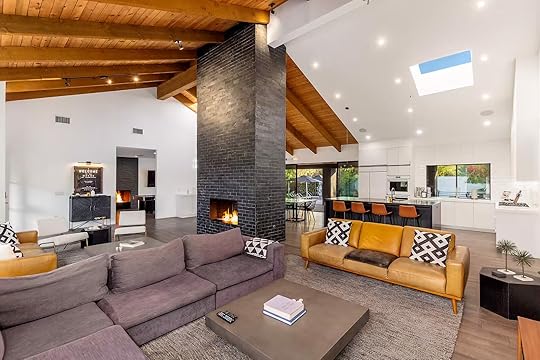 Photo: Airbnb
Photo: Airbnb Photo: Airbnb
Photo: AirbnbSee more photosThis one’s a keeper; you’ll definitely consider splashing out for the full four weeks of the tournament. Standing between Phoenix and Scottsdale, Arizona, this deluxe Airbnb is 8,000 square feet of play, luxury, and relaxation. There’s a heated pool, hot tub, and mini golf in the backyard for blowing off steam between games. Indoors, you’ll find a games room, yoga studio, sauna, and that all-important movie theater for a FIFA World Cup watch party.
Sixteen+ guests, nine bedrooms
Price: $3,155 per night
More Phoenix Airbnbs
 Photo: Airbnb
Photo: Airbnb Photo: Airbnb
Photo: Airbnb Photo: Airbnb
Photo: Airbnb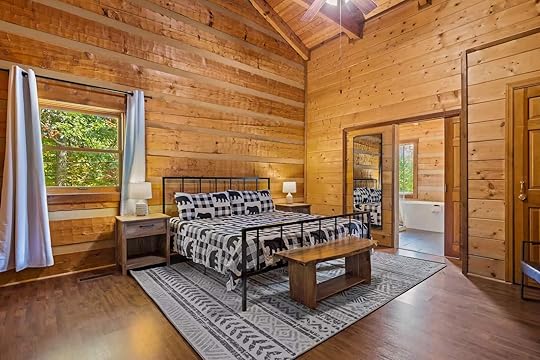 Photo: Airbnb
Photo: AirbnbSee more photosThis charming chalet in Gatlinburg, Tennessee, caters to all needs during the 2026 World Cup. The home theater has leather loungers, squashy bean bags, and surround sound to make you feel like you’re right there on the pitch. In between matches, you’ll debrief in the hot tub and compete with loved ones in the games room. Soccer aside, the Smoky Mountain backdrop is unreal and evenings are all about the fireside s’mores.
Fifteen guests, four bedrooms
Price: $1,245 per night
More Gatlinburg Airbnbs
 Photo: Airbnb
Photo: Airbnb Photo: Airbnb
Photo: Airbnb Photo: Airbnb
Photo: Airbnb Photo: Airbnb
Photo: AirbnbSee more photosThis champion Airbnb in Denver, Colorado, is steps from some of the city’s coolest breweries where you can toast (or commiserate) the latest results. The movie room features a 120″ projector, surround sound, and a couch so comfy you’ll want every game to go into extra time. There’s a lovely backyard with a fire pit and a patio furnished with a grill to make the most of those summer evenings in the mountain state.
Eight guests, four bedrooms
Price: $805 per night
More Denver Airbnbs
 Photo: Airbnb
Photo: Airbnb Photo: Airbnb
Photo: Airbnb Photo: Airbnb
Photo: Airbnb Photo: Airbnb
Photo: AirbnbSee more photosKeep an eye on the score from the pool at this Guest Favorite rental in Las Vegas. Besides the screen in the swimming pool room, there’s space for an alternative watch party in the movie theater. Even the main lounge does the job for watching the game, so you’ll not miss a single Red Card. The house has six sizable bedrooms and an entertainment room as good as anything you’d find on The Strip.
Sixteen+ guests, six bedrooms
Price: $1,567 per night
More Las Vegas Airbnbs
 Photo: Airbnb
Photo: Airbnb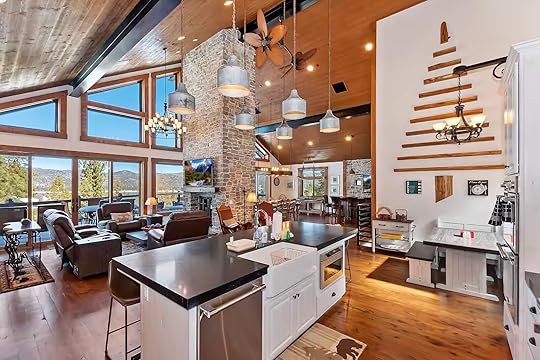 Photo: Airbnb
Photo: Airbnb Photo: Airbnb
Photo: Airbnb Photo: Airbnb
Photo: AirbnbSee more photosKill two birds with one stone by booking this knockout Airbnb in Big Bear Lake, California. Footie fans can cheer on the national team in the movie lounge while other members of the clan luxuriate in the hot tub overlooking the mountains or shoot hoops in the yard. There’s a games room with foosball and poker for some light-hearted competition ahead of kick-off. Not forgetting, the alpine location will boost everyone’s athleticism.
Sixteen+ guests, five bedrooms
Price: $724 per night
More Big Bear Airbnbs
 Photo: Airbnb
Photo: Airbnb Photo: Airbnb
Photo: Airbnb Photo: Airbnb
Photo: Airbnb Photo: Airbnb
Photo: AirbnbSee more photosRise and shine early to explore local hiking trails, vineyards, and watersports before settling down to stream the game in the movie lounge with reclining chairs. This Airbnb in Blue Ridge, Georgia, has a hot tub and a games room for half-time entertainment. The main living area is open plan with a second TV area served by a chunky modular couch which works just as well for an opponent watch party.
Twelve guests, five bedrooms
Price: $747 per night
More Georgia Airbnbs
 Photo: Airbnb
Photo: Airbnb Photo: Airbnb
Photo: Airbnb Photo: Airbnb
Photo: Airbnb Photo: Airbnb
Photo: AirbnbSee more photosSchedule a 2026 World Cup watch party in the Sunshine State and you’ll be the man (or woman) of the match long before the whistle blows. One room sports a Fantasy Football theme while the movie den takes care of the practicalities of where to screen the games. The twelve-bedroom house in Davenport, Florida, is ideal for families with kids as well as adult-only groups. It has a retro game room and – crucial for Floridian summers – a screened-in pool.
Sixteen+ guests, twelve bedrooms
Price: $929 per night
More Florida Airbnbs
 Photo: Airbnb
Photo: Airbnb Photo: Airbnb
Photo: Airbnb Photo: Airbnb
Photo: Airbnb Photo: Airbnb
Photo: AirbnbSee more photosRent this Airbnb in Sterling, Kentucky, for the 2026 World Cup and you’ll get to balance watch parties with as much sport as you have the energy for. Besides the 30-person private movie theater there’s a mini golf course, a basketball court, a soccer field, and a pickleball court. Those seeking a slower pace can hang out in the speakeasy-style bourbon bar, shoot some darts, or while away an afternoon in one of the two hot tubs.
Sixteen+ guests, seven bedrooms
Price: $2,000 per night
 Photo: Airbnb
Photo: Airbnb Photo: Airbnb
Photo: Airbnb Photo: Airbnb
Photo: Airbnb Photo: Airbnb
Photo: AirbnbSee more photosWarning: the TV room at this townhouse in Philadelphia, Pennsylvania, is so comfortable there’s a high chance of nodding off and missing the winning goal. When you’re not biting your nails downstairs, the rooftop terrace is nicely furnished for nibbles and beers while making the most of those long summer evenings. The host can hook you up with a private chef or an at-home pizza masterclass to fill the gaps between games.
Sixteen+ guests, four bedrooms
Price: $627 per night
More Philadelphia Airbnbs
 Photo: Airbnb
Photo: Airbnb Photo: Airbnb
Photo: Airbnb Photo: Airbnb
Photo: Airbnb Photo: Airbnb
Photo: AirbnbSee more photosOnce you’ve dumped your bags in this mammoth Airbnb in downtown Atlanta, Georgia, you can throw yourself into soccer, play, and pampering. With a touch of the tropics and a dash of urban chic, the house has a hot tub and yoga studio for indulging in a spot of post-match wellness. There’s a movie theater for cheering on your favorite player and, for those with tickets, Mercedes-Benz Stadium is a 10-minute Uber.
Sixteen+ guests, four bedrooms
Price: $735 per night
More Atlanta Airbnbs
 Photo: Airbnb
Photo: Airbnb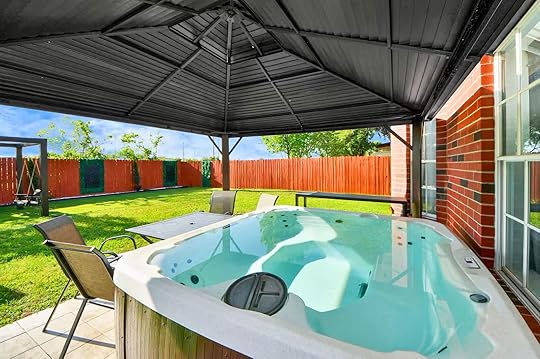 Photo: Airbnb
Photo: Airbnb Photo: Airbnb
Photo: Airbnb Photo: Airbnb
Photo: AirbnbSee more photosYou’ll want extra time of your own at this Guest Favorite Airbnb in Houston, Texas. There’s an over-the-top luxe movie lounge where you can follow the latest matches while the backyard is turned out with a putting green, yard games, and a hot tub. This five-bedroom house also provides ample space for either “far and wide” or sociable downtime, either in the plush private domains or in the main living areas.
Twelve guests, five bedrooms
Price: $759 per night
More Houston Airbnbs
 Photo: Airbnb
Photo: Airbnb Photo: Airbnb
Photo: Airbnb Photo: Airbnb
Photo: Airbnb Photo: Airbnb
Photo: AirbnbSee more photosThis one-size-fits-all Airbnb in Los Angeles, California, has a funky design that makes you feel like you’ve stepped into a video game or a toy factory. It’s a great pick for families with kids and adult groups alike, with plenty to entertain so-so soccer fans through to diehard devotees. All communal spaces and bedrooms are themed as per the classics: Harry Potter, Jurassic Park, and The Simpsons. There are TVs in the retro lounge and the games room.
Eight guests, three bedrooms
Price: $757 per night
More Los Angeles Airbnbs
 Photo: Airbnb
Photo: Airbnb Photo: Airbnb
Photo: Airbnb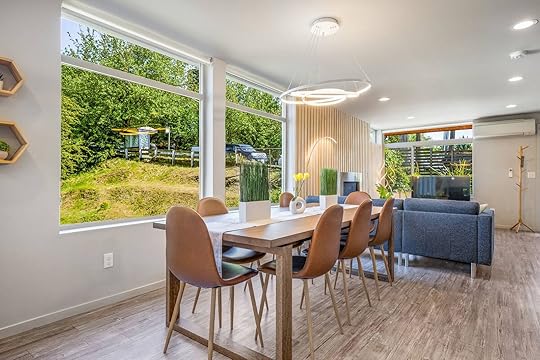 Photo: Airbnb
Photo: Airbnb Photo: Airbnb
Photo: AirbnbSee more photosThis stylish four-bedroom rental in the Central District of Seattle is recommended for smaller groups looking to juggle soccer with exploring Washington’s Great Outdoors. The boutique decor is soothing while the kitchen makes cooking on vacation feel less like a chore. Opt to watch the games in the main lounge or hunker down in the home movie room, complete with its own popcorn maker. For those with tickets, Lumen Field is less than 15 minutes by car.
Eight guests, four bedrooms
Price: $839 per night
More Seattle Airbnbs
 Photo: Airbnb
Photo: Airbnb Photo: Airbnb
Photo: Airbnb Photo: Airbnb
Photo: Airbnb Photo: Airbnb
Photo: AirbnbSee more photosThis roomy apartment with a home theater and private backyard is a workaround for New York City’s stricter Airbnb regulations. Convenient for downtown Manhattan, Newark Liberty, and MetLife Stadium, you can make the most of both sides of the state line while waiting for kick-off. Furnished with a home gym and designated office with multiple desks, it’s not a bad shout to reserve the entire month if you’re a remote worker.
Six guests, three bedrooms
Price: $627 per night
More NYC Airbnbs
 Photo: Airbnb
Photo: Airbnb Photo: Airbnb
Photo: Airbnb Photo: Airbnb
Photo: Airbnb Photo: Airbnb
Photo: AirbnbSee more photosThis top-rated Favorite Airbnb is located in Lenexa on the outskirts of Kansas City, Missouri, where Arrowhead Stadium will play a role in hosting the 2026 FIFA World Cup. The main TV area is nestled under the vaulted ceilings with hefty leather recliners to support you through those tense moments. This kid-friendly property has an open-concept design so you can keep watch over the little ones during the games and kick a ball around in the yard at halftime.
Ten guests, four bedrooms
Price: $379 per night
More Kansas City Airbnbs
 Photo: Airbnb
Photo: Airbnb Photo: Airbnb
Photo: Airbnb Photo: Airbnb
Photo: Airbnb Photo: Airbnb
Photo: AirbnbSee more photosIf watching the national team re-inspires you to hit the gym, this funky Airbnb in Chicago, Illinois, makes it easy with a home workout studio. Shared only with the first-floor unit when it’s occupied, the lawn is available for a friendly kick around. Back inside, the television lounge is kitted out with ultra-soft velvet couches where you can watch the games in comfort. Chicago O’Hare International Airport is a 15-minute drive and the unit has an EV charger.
Eight guests, three bedrooms
Price: $400 per night
More Chicago Airbnbs
 Photo: Airbnb
Photo: Airbnb Photo: Airbnb
Photo: Airbnb Photo: Airbnb
Photo: Airbnb Photo: Airbnb
Photo: AirbnbSee more photosPlan an awesome Louisiana getaway combining soccer, Creole cuisine, and late-night jazz at this cozy abode. Separated from the main living areas, the home theater has seven theater chairs with tables for watching the action. The house is four blocks from the trolley which gets you to the French Quarter in minutes but there are dozens of restaurants and bars within walking distance. This rental pad welcomes families as well as adult groups.
Six guests, three bedrooms
Price: $312 per night
More New Orleans Airbnbs
 Photo: Airbnb
Photo: Airbnb Photo: Airbnb
Photo: Airbnb Photo: Airbnb
Photo: Airbnb Photo: Airbnb
Photo: AirbnbSee more photosThis top-notch Airbnb in Arvada, Colorado, is a win-win for football fanatics as well as groups eager to get out and explore the Rockies. The decor carries a hotel flair whereas the backyard (complete with lawn games, ping pong and a grill) makes it feel like home away from home. There are several communal nooks for chatting and relaxing while watch parties can be held in the movie den in front of the 85″ TV.

Fourteen guests, five bedrooms
Price: $718 per night
More Colorado Airbnbs
Matador Network's Blog
- Matador Network's profile
- 6 followers



